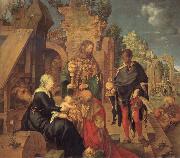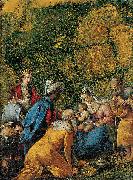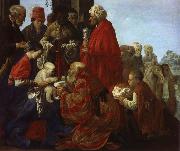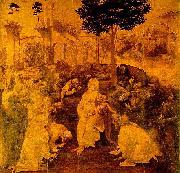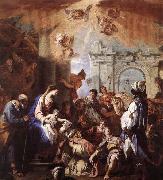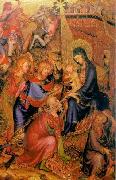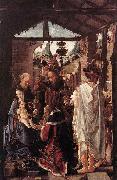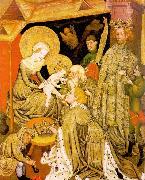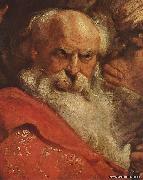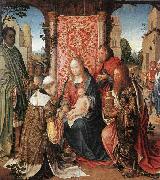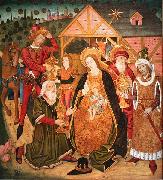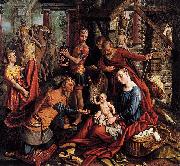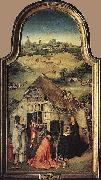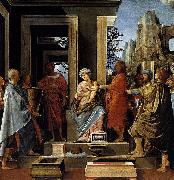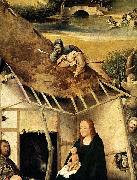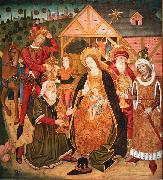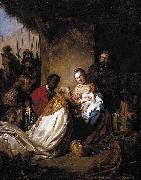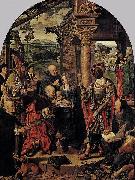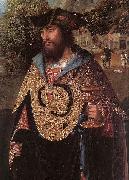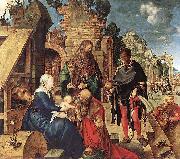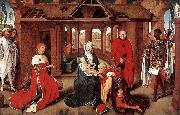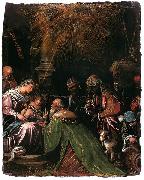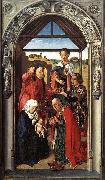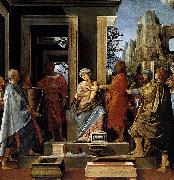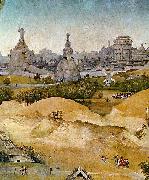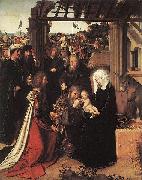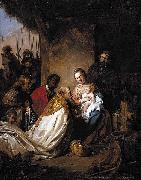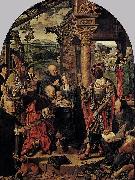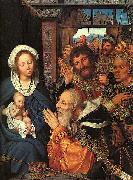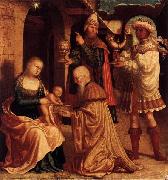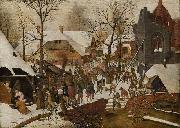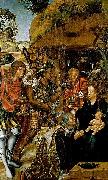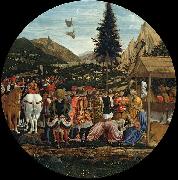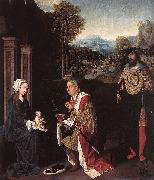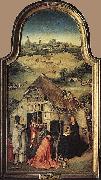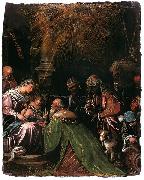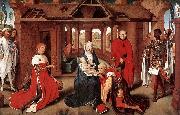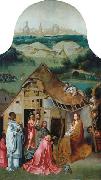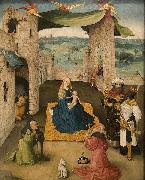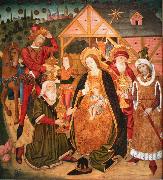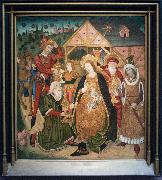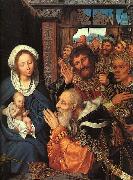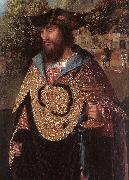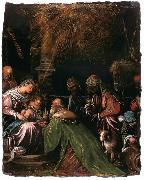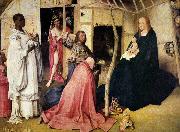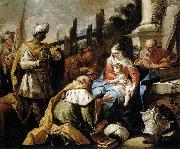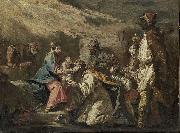Wholesale Oil Painting No Minimum |
|||||||||||
|
|
|||||||||||

|
|||||||||||
|
|
|
||||||||
Sandro BotticelliItalian Early Renaissance Painter, 1445-1510 Italian painter and draughtsman. In his lifetime he was one of the most esteemed painters in Italy, enjoying the patronage of the leading families of Florence, in particular the Medici and their banking clients. He was summoned to take part in the decoration of the Sistine Chapel in Rome, was highly commended by diplomatic agents to Ludovico Sforza in Milan and Isabella d Este in Mantua and also received enthusiastic praise from the famous mathematician Luca Pacioli and the humanist poet Ugolino Verino. By the time of his death, however, Botticelli s reputation was already waning. He was overshadowed first by the advent of what Vasari called the maniera devota, a new style by Perugino, Francesco Francia and the young Raphael, whose new and humanly affective sentiment, infused atmospheric effects and sweet colourism took Italy by storm; he was then eclipsed with the establishment immediately afterwards of the High Renaissance style, which Vasari called the modern manner, in the paintings of Michelangelo and the mature works of Raphael in the Vatican. From that time his name virtually disappeared until the reassessment of his reputation that gathered momentum in the 1890s |
||||||||
|
|
||||||||
The Adoration of the Magi
The Adoration of the Magi Painting ID:: 129 |
1475
Galleria degli Uffizi, Florence 1475 Galleria degli Uffizi, Florence |
|||||||
|
|
||||||||
Peter Paul RubensFlemish Baroque Era Painter, 1577-1640 Peter Paul Rubens (June 28, 1577 ?C May 30, 1640) was a prolific seventeenth-century Flemish Baroque painter, and a proponent of an exuberant Baroque style that emphasized movement, color, and sensuality. He is well-known for his Counter-Reformation altarpieces, portraits, landscapes, and history paintings of mythological and allegorical subjects. In addition to running a large studio in Antwerp which produced paintings popular with nobility and art collectors throughout Europe, Rubens was a classically-educated humanist scholar, art collector, and diplomat who was knighted by both Philip IV, king of Spain, and Charles I, king of England. Rubens was a prolific artist. His commissioned works were mostly religious subjects, "history" paintings, which included mythological subjects, and hunt scenes. He painted portraits, especially of friends, and self-portraits, and in later life painted several landscapes. Rubens designed tapestries and prints, as well as his own house. He also oversaw the ephemeral decorations of the Joyous Entry into Antwerp by the Cardinal-Infante Ferdinand in 1635. His drawings are mostly extremely forceful but not detailed; he also made great use of oil sketches as preparatory studies. He was one of the last major artists to make consistent use of wooden panels as a support medium, even for very large works, but he used canvas as well, especially when the work needed to be sent a long distance. For altarpieces he sometimes painted on slate to reduce reflection problems. His fondness of painting full-figured women gave rise to the terms 'Rubensian' or 'Rubenesque' for plus-sized women. The term 'Rubensiaans' is also commonly used in Dutch to denote such women. |
||||||||
|
|
||||||||
|
|
The Adoration of the Magi
The Adoration of the Magi Painting ID:: 3641 |
1617-18
Musee des Beaux Arts, Lyons 1617-18 Musee des Beaux Arts, Lyons |
||||||
|
|
||||||||
RICCI, SebastianoItalian painter, Venetian school (b. 1659, Belluno, d. 1734, Venezia).Painter and draughtsman. He painted light and colourful religious, historical and mythological subjects with a fluid, painterly touch. His rediscovery of Paolo Veronese, whose settings and costumes he borrowed, was important to later Venetian painters. Sebastiano was an itinerant artist, celebrated throughout Europe. |
||||||||
|
|
||||||||
|
|
The Adoration of the Magi
The Adoration of the Magi Painting ID:: 8922 |
1726-30
Oil on canvas, 330,2 x 289,6 cm
Royal Collection, 1726-30 Oil on canvas, 330,2 x 289,6 cm Royal Collection, |
||||||
|
|
||||||||
Maino, Juan Bautista delSpanish Baroque Era Painter, 1578-1649 |
||||||||
|
|
||||||||
|
|
The Adoration of the Magi
The Adoration of the Magi Painting ID:: 19250 |
Oil on canvas
Museo del Prado, Madrid. Oil on canvas Museo del Prado, Madrid. |
||||||
|
|
||||||||
Parentino, BernardoItalian Painter, 1437-1531 was an Italian painter of the Renaissance period, active mainly in Padua. Born in Parenzo, then a Venetian town in Istria and died in Vicenza. He was influenced, if not a pupil, of the painter Andrea Mantegna. He became an Augustinian monk under name of Lorenzo. He painted Scenes of the life of San Benedetto for the cloister of Santa Giustina at Padua, and a Nativity once at the Accademia in Venice. He painted a nightmarish Temptation of St. Anthony Abbot found at the Doria Pamphilj Gallery. An Adoration of the Magi |
||||||||
|
|
||||||||
|
|
The Adoration of the Magi
The Adoration of the Magi Painting ID:: 19760 |
Panel
Musee du Louvre, Paris. Panel Musee du Louvre, Paris. |
||||||
|
|
||||||||
|
|
||||||||
|
|
The Adoration of the magi
The Adoration of the magi Painting ID:: 27366 |
mk56
oil on canvas
Venetian School,circa 1600
mk56 oil on canvas Venetian School,circa 1600 |
||||||
|
|
||||||||
Maino, Juan Bautista delSpanish Baroque Era Painter, 1578-1649 |
||||||||
|
|
||||||||
|
|
The Adoration of the Magi
The Adoration of the Magi Painting ID:: 28113 |
mk61
Oil on canvas
315x174cm
mk61 Oil on canvas 315x174cm |
||||||
|
|
||||||||
BERRUGUETE, PedroSpanish Early Renaissance Painter, ca.1450-1504 Pedro Berruguete (c. 1450 ?C 1504) was a Spanish painter, his art is regarded as a transitional style between gothic and renaissance. Born in Paredes de Nava, Spain, he went to Italy in 1480 and worked in Federigo da Montefeltro's court in Urbino. He came back Spain 1482 and painted in several cities as Sevilla, Toledo and Ávila. He was father of an important sculptor, Alonso Berruguete, considered the most important sculptor in Renaissance Spain. |
||||||||
|
|
||||||||
|
|
The Adoration of the Magi
The Adoration of the Magi Painting ID:: 28527 |
mk61
Gouache on twilled canvas
350x206cm
mk61 Gouache on twilled canvas 350x206cm |
||||||
|
|
||||||||
Hans MemlingNetherlandish Northern Renaissance Painter, ca.1435-1494 Born in Seligenstadt, near Frankfurt in the Middle Rhein region, it is believed that Memling served his apprenticeship at Mainz or Cologne, and later worked in the Netherlands under Rogier van der Weyden (c. 1455?C1460). He then went to Bruges around 1465. There is an apocryphical story that he was a wounded at the Battle of Nancy, sheltered and cured by the Hospitallers at Bruges, and that to show his gratitude he refused payment for a picture he had painted for them. Memling did indeed paint for the Hospitallers, but he painted several pictures for them, in 1479 and 1480, and it is likely that he was known to his patrons of St John, prior to the Battle of Nancy. Memling is connected with military operations only in a distant sense. His name appears on a list of subscribers to the loan which was raised by Maximilian I of Austria, to defend against hostilities towards France in 1480. In 1477, when he was incorrectly claimed to have been killed, he was under contract to create an altarpiece for the gild-chapel of the booksellers of Bruges. This altarpiece, under the name of the Seven Griefs of Mary, is now in the Gallery of Turin. It is one of the fine creations of his more mature period. It is not inferior in any way to those of 1479 in the hospital of St. John, which for their part are hardly less interesting as illustrative of the master's power than The Last Judgment which can be found since the 1470s in the St. Mary's Church, Gda??sk. Critical opinion has been unanimous in assigning this altarpiece to Memling. This affirms that Memling was a resident and a skilled artist at Bruges in 1473; for the Last Judgment was undoubtedly painted and sold to a merchant at Bruges, who shipped it there on board of a vessel bound to the Mediterranean, which was captured by Danzig privateer Paul Beneke in that very year. This purchase of his pictures by an agent of the Medici demonstrates that he had a considerable reputation. |
||||||||
|
|
||||||||
|
|
The Adoration of the Magi
The Adoration of the Magi Painting ID:: 28696 |
mk61
Oil on panel
95x145cm
mk61 Oil on panel 95x145cm |
||||||
|
|
||||||||
BOSCH, HieronymusNetherlandish Northern Renaissance Painter, ca.1450-1516 Bosch produced several triptychs. Among his most famous is The Garden of Earthly Delights. This painting depicts paradise with Adam and Eve and many wondrous animals on the left panel, the earthly delights with numerous nude figures and tremendous fruit and birds on the middle panel, and hell with depictions of fantastic punishments of the various types of sinners on the right panel. When the exterior panels are closed the viewer can see, painted in grisaille, God creating the Earth. These paintings have a rough surface from the application of paint; this contrasts with the traditional Flemish style of paintings, where the smooth surface attempts to hide the fact that the painting is man-made. Bosch never dated his paintings and may have signed only some of them (other signatures are certainly not his). Fewer than 25 paintings remain today that can be attributed to him. Philip II of Spain acquired many of Bosch's paintings after the painter's death; as a result, the Prado Museum in Madrid now owns several of his works, including The Garden of Earthly Delights. |
||||||||
|
|
||||||||
|
|
The Adoration of the Magi
The Adoration of the Magi Painting ID:: 28697 |
mk61
c.1510
Oil on panel
138x33cm
mk61 c.1510 Oil on panel 138x33cm |
||||||
|
|
||||||||
Domenico GhirlandaioItalian 1449-1494 Domenico Ghirlandaio Galleries Painter, mosaicist and possibly goldsmith. He was head of one of the most active workshops in late 15th-century Florence. He developed a style of religious narrative that blended the contemporary with the historical in a way that updated the basic tenets of early Renaissance art. Domenico documented material situation |
||||||||
|
|
||||||||
|
|
The Adoration of the Magi
The Adoration of the Magi Painting ID:: 28872 |
mk65
Oil on panel
67 11/16in
mk65 Oil on panel 67 11/16in |
||||||
|
|
||||||||
Gentile da FabrianoFabriano ca 1370-Rome 1427 Italian painter, one of the outstanding exponents of the elegant international Gothic style. In 1409 he worked in the Doge's Palace, Venice, painting historical frescoes that subsequently perished. In 1422 he was in Florence where he created his most celebrated painting, the resplendent Strozzi altarpiece (Uffizi). Gentile painted in the spirit and the manner of the older school, with glowing color and lavish use of gilt, thereby achieving a jewellike, courtly style. By 1425 he had responded to the new Florentine realism. His refined forms yielded to a sturdier rendering of figures in the Quaratesi altarpiece (panels are now in the Uffizi; Vatican; National Gall., London; and National Gall. of Art, Washington, D.C.). From 1425 until his death he worked in Siena, Orvieto, and Rome. Gentile died in Rome before the completion of the frescoes of St. John the Baptist in the Lateran Basilica. |
||||||||
|
|
||||||||
|
|
The Adoration of the Magi
The Adoration of the Magi Painting ID:: 28909 |
mk65
Tempera on panel,
68 1/8x86 5/8in
Uffizi, mk65 Tempera on panel, 68 1/8x86 5/8in Uffizi, |
||||||
|
|
||||||||
Lorenzo MonacoItalian c1370-c1424 Lorenzo Monaco Gallery was a Florentine painter. He joined the Camaldolese monastery of Santa Maria degli Angeli in Florence in 1391, but he left monastic life before making a lifetime commitment. Despite this fact, he has traditionally been called "Lawrence the Monk." His work shows the influence of the International Gothic style of the late fourteenth century, as well as that of the Sienese school. |
||||||||
|
|
||||||||
|
|
The Adoration of the Magi
The Adoration of the Magi Painting ID:: 29722 |
mk67
Tempera on panel
45 5/16x66 15/16in
Uffizi,Gallery
mk67 Tempera on panel 45 5/16x66 15/16in Uffizi,Gallery |
||||||
|
|
||||||||
Filippino LippiItalian 1457-1504 Filippino Lippi Galleries Born Filippo Lippi in Prato (Tuscany), the illegitimate son of the painter Fra Filippo Lippi and nun Lucrezia Buti, Filippino first trained under his father. They moved to Spoleto, where Filippino served as shop adjuvant in the construction of the Cathedral there. When his father died in 1469, he completed the frescos with Storie della Vergine (Histories of the Virgin) in the cathedral. Filippino Lippi completed his apprenticeship in the workshop of Botticelli, who had been a pupil of Filippino's father. In 1472, Botticelli also took him as his companion in the Compagnia di San Luca. His first works greatly resemble those of Botticelli's, but with less sensitivity and subtlety. The very first ones (dating from 1475 onwards) were initially attributed to an anonymous "Amico di Sandro" ("Friend of Botticelli"). Eventually Lippi's style evolved into a more personal and effective one in the years 1480-1485. Works of the early period include: the Madonnas of Berlin, London and Washington, the Journeys of Tobia of the Galleria Sabauda in Turin, Italy, the Madonna of the Sea of Galleria dell'Accademia and the Histories of Ester. Together with Perugino, Ghirlandaio and Botticelli, Lippi worked on the frescoed decoration of Lorenzo de Medici's villa at Spedaletto. On December 31, 1482 he was commissioned to work on a wall of Sala dell'Udienza of Palazzo Vecchio in Florence (a work never begun). Soon after (probably in 1483-1484) he was called to complete Masaccio's decoration of Brancacci Chapel in the church of the Carmine, left unfinished by the artist's death in 1428 . Here he realized the Stories of Saint Peter on the following frescoes: Quarrel with Simon Magus in face of Nero, Resurrection of Teophilus' Son, Saint Peter Jailed, Liberation and Saint Peter's Crucifixion. The work on the Sala degli Otto di Pratica, in the Palazzo Vecchio, started on February 20, 1486. It is now in the Uffizi Gallery. In the same years Piero di Francesco del Pugliese asked him to paint the altarpiece with Apparition of the Virgin to St. Bernard, now in the Badia Fiorentina, Florence. This is Lippi's most popular picture: a composition of unreal items, with its very particular elongated figures, backed by a phantasmagorical scenario of rocks and almost anthropomorphic trunks. The work can be dated to the 1480-1486 years. Eventually he worked for Tanai de' Nerli in the Saint Spirit's Church. On April 21, 1487, Filippo Strozzi asked him to decorate the family chapel in Santa Maria Novella with the Stories of St. John Evangelist and St. Philip. He worked on this piece intermittently, only completing it in 1503, after the customer's death. The windows with musical themes, also designed by Filippino, were completed between June and July 1503. These paintings can be seen as a mirror of the political and religious crisis in Florence at the time: the theme of the fresco, the clash between Christianity and Paganism, was hotly debated in the Florence of Girolamo Savonarola. Filippino showed his characters in a landscape which recreated the ancient world in its finest details, showing the influence of the Grottesco style he had seen in his journey to Rome. He created in this way an "animated", mysterious, fantastic but also disquieting style, showing the unreality of something as a nightmare. In this way, Filippino portrayed ruthless executioners deformed by grim faces, who raged against the Saints. In the scene with St. Philip expelling a monster from the temple, the statue of the pagan god is a living figure which seems to dare the Christian saint. In 1488, Lippi moved to Rome, where Lorenzo de' Medici had advised Cardinal Oliviero Carafa to entrust him the decoration of the family chapel in Santa Maria sopra Minerva. These frescoes show a new kind of inspiration, quite different from the earlier works, but confirm his continued research on the themes of the Ancient era. Lippi finished the cycle by 1493. Lippi's return to Florence is variously assigned to the years going from 1491 to 1494 . Works of this period include: Apparition of Christ to Madonna (1493, now in Munich), Adoration of the Magi (1496, for the church of San Donato in Scopeto, now in the Uffizi), Sacrifice of Lacoön (end of the century, for the villa of Lorenzo de' Medici at Poggio a Caiano), St. John Baptist and Maddalena (Valori Chapel in San Procolo, Florence, inspired in some way to Luca Signorelli's art). He also worked outside of his mother-country, namely on the Certosa of Pavia and in Prato, where in 1503 he completed the Tabernacle of the Christmas Song, now in the City Museum; in 1501 Lippi realized the Mystic Wedding of St. Catherine for the Basilica of San Domenico in Bologna. Lippi's last work is the Deposition for the Santissima Annunziata church in Florence, which at his death in April 1504 was unfinished. He was so renowned that all the workshops of the city closed on the day of his burial. |
||||||||
|
|
||||||||
|
|
The Adoration of the Magi
The Adoration of the Magi Painting ID:: 29763 |
mk67
Tempera on panel
101 9/16x95 11/16in
Uffizi,Gallery
mk67 Tempera on panel 101 9/16x95 11/16in Uffizi,Gallery |
||||||
|
|
||||||||
Gerard Davidb.c. 1460, Oudewater, Neth. d.Aug. 13, 1523, Bruges Flemish Gerard David Locations Netherlandish painter. He is known as the last of the Flemish Primitives. Although born in the northern Netherlands, he moved to Bruges as a young man, and most of his work expresses the impassive, unmannered, microscopically realistic approach peculiar to south Netherlandish art in the time of Jan van Eyck. David was skilled at synthesizing the art of several important south Netherlandish predecessors, adapting, for instance, the compositions of van Eyck and the technique of Hugo van der Goes. He was also influenced by Hans Memling, whose example led him to refine and polish his cruder northern Netherlandish style and to adopt the popular theme of the Virgin and Child enthroned. |
||||||||
|
|
||||||||
|
|
The Adoration of the Magi
The Adoration of the Magi Painting ID:: 29823 |
mk67
Tempera on panel
37 3/8x31 1/2in
Uffizi,Gallery
mk67 Tempera on panel 37 3/8x31 1/2in Uffizi,Gallery |
||||||
|
|
||||||||
PontormoItalian Mannerist Painter, 1494-ca.1556 Italian painter and draughtsman. He was the leading painter in mid-16th-century Florence and one of the most original and extraordinary of Mannerist artists. His eccentric personality, solitary and slow working habits and capricious attitude towards his patrons are described by Vasari; his own diary, which covers the years 1554-6, further reveals a character with neurotic and secretive aspects. Pontormo enjoyed the protection of the Medici family throughout his career but, unlike Agnolo Bronzino and Giorgio Vasari, did not become court painter. His subjective portrait style did not lend itself to the state portrait. He produced few mythological works and after 1540 devoted himself almost exclusively to religious subjects. His drawings, mainly figure studies in red and black chalk, are among the highest expressions of the great Florentine tradition of draughtsmanship; close to 400 survive, forming arguably the most important body of drawings by a Mannerist painter. |
||||||||
|
|
||||||||
|
|
The Adoration of the Magi
The Adoration of the Magi Painting ID:: 29851 |
mk67
Oil on panel
33 7/16x74 13/16in
Pitti,Palatine Gallery
mk67 Oil on panel 33 7/16x74 13/16in Pitti,Palatine Gallery |
||||||
|
|
||||||||
Albrecht Durerb.May 21, 1471, Imperial Free City of Nernberg [Germany] d.April 6, 1528, Nernberg Albrecht Durer (May 21, 1471 ?C April 6, 1528) was a German painter, printmaker and theorist from Nuremberg. His still-famous works include the Apocalypse woodcuts, Knight, Death, and the Devil (1513), Saint Jerome in his Study (1514) and Melencolia I (1514), which has been the subject of extensive analysis and interpretation. His watercolours mark him as one of the first European landscape artists, while his ambitious woodcuts revolutionized the potential of that medium. D??rer introduction of classical motifs into Northern art, through his knowledge of Italian artists and German humanists, have secured his reputation as one of the most important figures of the Northern Renaissance. This is reinforced by his theoretical treatise which involve principles of mathematics, perspective and ideal proportions. His prints established his reputation across Europe when he was still in his twenties, and he has been conventionally regarded as the greatest artist of the Renaissance in Northern Europe ever since. |
||||||||
|
|
||||||||
|
|
The Adoration of the Magi
The Adoration of the Magi Painting ID:: 29924 |
mk67
Oil on panel
39x44 1/16in
Uffizi,Gallery
mk67 Oil on panel 39x44 1/16in Uffizi,Gallery |
||||||
|
|
||||||||
BASTIANI, LazzaroItalian painter, Venetian school (b. 1449, Venezia, d. 1512, Venezia) Italian painter. He is first recorded in 1449, as a painter in Venice and in 1460 he was paid for an altarpiece in S Samuele there. Although no extant work is securely documented, several are signed and two are dated. The influence of Andrea del Castagno is clear in his early works, of the 1460s: the signed mosaic of St Sergius (Venice, S Marco), the Archangel Gabriel (Padua, Mus. Civ.) and the signed Piet? (Venice, S Antonino). Also assigned to this period are the Adoration of the Magi (New York, Frick), the polyptych of St Francis (Matera, S Francesco), the St Jerome. |
||||||||
|
|
||||||||
|
|
The Adoration of the magi
The Adoration of the magi Painting ID:: 31721 |
mk76
Painted probably between 1470 and 1480
Tempera on panel
20 1/2x11in
mk76 Painted probably between 1470 and 1480 Tempera on panel 20 1/2x11in |
||||||
|
|
||||||||
Fra AngelicoFra Angelico Galleries b.c. 1400, Vicchio, Florence d.Feb. 18, 1455, Rome Fra Angelico (c. 1395 ?C February 18, 1455), born Guido di Pietro, was an Early Italian Renaissance painter, referred to in Vasari's Lives of the Artists as having "a rare and perfect talent". Known in Italy as il Beato Angelico, he was known to his contemporaries as Fra Giovanni da Fiesole (Brother John from Fiesole). In Giorgio Vasari's Lives of the Artists, written prior to 1555, he was already known as Fra Giovanni Angelico (Brother Giovanni the Angelic One). Within his lifetime or shortly thereafter he was also called Il Beato (the Blessed), in reference to his skills in painting religious subjects. In 1982 Pope John Paul II conferred beatification, thereby making this title official. Fiesole is sometimes misinterpreted as being part of his formal name, but it was merely the name of the town where he took his vows, used by contemporaries to separate him from other Fra Giovannis. He is listed in the Roman Martyrology as Beatus Ioannes Faesulanus, cognomento Angelicus??"Blessed Giovanni of Fiesole, nicknamed Angelico". Fra Angelico was working at a time when the style of painting was in a state of change. This process of change had begun a hundred years previous with the works of Giotto and several of his contemporaries, notably Giusto de' Menabuoi, both of whom had created their major works in Padua, although Giotto was trained in Florence by the great Gothic artist, Cimabue, and painted a fresco cycle of St Francis in the Bardi Chapel in Santa Croce. Giotto had many enthusiastic followers, who imitated his style in fresco, some of them, notably the Lorenzetti, achieving great success. |
||||||||
|
|
||||||||
|
|
The Adoration of the Magi
The Adoration of the Magi Painting ID:: 32108 |
mk78
c.1435
Tempera on panel
39x56cm
Florence,
Museo di San Marco
mk78 c.1435 Tempera on panel 39x56cm Florence, Museo di San Marco |
||||||
|
|
||||||||
Fra Filippo LippiItalian 1406-1469 Fra Filippo Lippi Galleries Lippi was born in Florence to Tommaso, a butcher. Both his parents died when he was still a child. Mona Lapaccia, his aunt, took charge of the boy. In 1420 he was registered in the community of the Carmelite friars of the Carmine in Florence, where remained until 1432, taking the Carmelite vows in 1421 when he was sixteen. In his Lives of the Artists, Vasari says: "Instead of studying, he spent all his time scrawling pictures on his own books and those of others," The prior decided to give him the opportunity to learn painting. Eventually Fra Filippo quit the monastery, but it appears he was not released from his vows; in a letter dated 1439 he describes himself as the poorest friar of Florence, charged with the maintenance of six marriageable nieces. In 1452 he was appointed chaplain to the convent of S. Giovannino in Florence, and in 1457 rector (Rettore Commendatario) of S. Quirico in Legania, and made occasional, considerable profits; but his poverty seems chronic, his money being spent, according to one account, in frequent amours. Vasari relates some romantic adventures of Fra Filippo that modern biographers are not inclined to believe. Except through Vasari, nothing is known of his visits to Ancona and Naples, nor of his capture by Barbary pirates and enslavement in Barbary, where his skill in portrait-sketching helped to release him. From 1431 to 1437 his career is not accounted for. Portrait of a Man and Woman at a Casement , c. 1440 Metropolitan Museum of Art, New York City.In June 1456 Fra Filippo is recorded as living in Prato (near Florence) to paint frescoes in the choir of the cathedral. In 1458, while engaged in this work, he set about painting a picture for the convent chapel of S. Margherita of Prato, where he met Lucrezia Buti, the beautiful daughter of a Florentine, Francesco Buti; she was either a novice or a young lady placed under the nuns' guardianship. Lippi asked that she might be permitted to sit for the figure of the Madonna (or perhaps S. Margherita). Under that pretext, Lippi engaged in sexual relations with her, abducted her to his own house, and kept her there despite the nuns' efforts to reclaim her. The result was their son Filippino Lippi, who became a painter no less famous than his father. Such is Vasari's narrative, published less than a century after the alleged events; it is not refuted by saying, more than three centuries later, that perhaps Lippo had nothing to do with any such Lucrezia, and perhaps Lippino was his adopted son, or only an ordinary relative and scholar. The argument that two reputed portraits of Lucrezia in paintings by Lippo are not alike, one as a Madonna in a very fine picture in the Pitti gallery, and the other in the same character in a Nativity in the Louvre, comes to very little; and it is reduced to nothing when the disputant adds that the Louvre painting is probably not done by Lippi at all[clarification needed]. Besides, it appears more likely that not the Madonna in the Louvre but a S. Margaret in a picture now in the Gallery of Prato is the original portrait (according to tradition) of Lucrezia Buti. The frescoes in the choir of Prato cathedral, which depict the stories of St John the Baptist and St Stephen on the two main facing walls, are considered Fra Filippo's most important and monumental works, particularly the figure of Salome dancing, which has clear affinities with later works by Sandro Botticelli, his pupil, and Filippino Lippi, his son, as well as the scene showing the ceremonial mourning over Stephen's corpse. This latter is believed to contain a portrait of the painter, but there are various opinions as to which is the exact figure. On the end wall of the choir are S. Giovanni Gualberto and S. Alberto, while the vault has monumental representations of the four evangelists. The close of Lippi's life was spent at Spoleto, where he had been commissioned to paint, for the apse of the cathedral, scenes from the life of the Virgin. In the semidome of the apse is Christ crowning the Madonna, with angels, sibyls and prophets. This series, which is not wholly equal to the one at Prato, was completed by Fra Diamante after Lippi's death. That Lippi died in Spoleto, on or about the 8th of October 1469, is a fact; the mode of his death is a matter of dispute. It has been said that the pope granted Lippi a dispensation for marrying Lucrezia, but before the permission arrived, Lippi had been poisoned by the indignant relatives of either Lucrezia herself or some lady who had replaced her in the inconstant painter's affections. This is now generally regarded as a fable, and indeed, a vendetta upon a man aged sixty-three for a seduction committed at the age of fifty-two seems hardly plausible. Fra Filippo lies buried in Spoleto, with a monument erected to him by Lorenzo the Magnificent; he had always been zealously patronized by the Medici family, beginning with Cosimo de Medici. Francesco di Pesello (called Pesellino) and Sandro Botticelli were among his most distinguished pupils. The altarpiece Lippi painted in 1441 for the nuns of S. Ambrogio is now a prominent attraction in the Academy of Florence, and was celebrated in Browning's well-known poem. It represents the coronation of the Virgin among angels and saints, including many Bernardine monks. One of these, placed to the right, is a half-length portrait of Lippo, pointed out by the inscription perfecit opus upon an angel's scroll. The price paid for this work in 1447 was 1200 Florentine lire, which seems surprisingly large. Selfportait with pupilsFor Germiniano Inghirami of Prato he painted the Death of St. Bernard. His principal altarpiece in this city is a Nativity in the refectory of S. Domenico ?? the Infant on the ground adored by the Virgin and Joseph, between Saints George and Dominic, in a rocky landscape, with the shepherds playing and six angels in the sky. In the Uffizi is a fine Virgin adoring the infant Christ, who is held by two angels; in the National Gallery, London, a Vision of St Bernard. The picture of the Virgin and Infant with an Angel, in this same gallery, also ascribed to Lippi, is disputable. Filippo Lippi died in 1469 while working on the frescos Storie della Vergine (Scenes of the life of the Virgin Mary, 1467 - 1469) in the apse of the Spoleto Cathedral. The Frescos show the Annunciation, the Funeral, the Adoration of the Child and the Coronation of the Virgin. A group of bystanders at the Funeral includes a self-portrait of Lippi together with his son Fillipino and his helpers Fra Diamante and Pier Matteo d'Amelia. Lippi was buried on the right side of the transept. The frescos were completed by Filippino Lippi, who also designed the funerary monument for his father. Although it was commissioned by Lorenzo de Medici it was not actually made until 1490 by an unknown Florentine sculptor. |
||||||||
|
|
||||||||
|
|
The Adoration of the Magi
The Adoration of the Magi Painting ID:: 32145 |
mk78
Washington,National Gallery of Art
mk78 Washington,National Gallery of Art |
||||||
|
|
||||||||
DOMENICO VENEZIANOItalian Early Renaissance Painter, ca.1400-1461 |
||||||||
|
|
||||||||
|
|
The Adoration of the Magi
The Adoration of the Magi Painting ID:: 32146 |
mk78
c.1439-40
Tempera on panel,
diameter 84 cm,Berlin,
Staatliche Museen Preussischer Kulturbesitz.
Gemaldegalerie
mk78 c.1439-40 Tempera on panel, diameter 84 cm,Berlin, Staatliche Museen Preussischer Kulturbesitz. Gemaldegalerie |
||||||
|
|
||||||||
MASSYS, QuentinFlemish Northern Renaissance Painter, ca.1465-1530 Quentin Massys, also spelled Matsys or Metsys, was born in Louvain, the son of a blacksmith. He is traditionally thought to have been trained in that craft by his father. Art in Louvain while Massys was growing up was dominated by Dirk Bouts. Massys became a member of the painters' guild in Antwerp in 1491 and died there in 1530. He represented a current of painting that flourished in Antwerp at this time of its sudden new prosperity. Erwin Panofsky (1953) described this trend, "archaism of around 1500," as "a prelude to, in fact a fact of, the Renaissance in Netherlandish painting," which prevailed in the southern Netherlands. The monumental Enthroned Madonna (Brussels), an early work by Massys, has features recalling both Robert Campin and Jan van Eyck. The central panel of Massys' imposing St. Anne Altarpiece, or the Holy Kinship (Brussels), which was commissioned for the church of St-Pierre in Louvain in 1507 and signed and dated 1509, has a prototype in the Holy Kinship of Geertgen tot Sint Jans. Even the physical types and costumes in Massys' version refer to Geertgen's. But Massys placed his rhythmically balanced figure groups in a domed, arcaded loggia that in architectural style appears to be reaching for a Renaissance vocabulary it cannot quite attain; certainly the architecture evokes a later period than that represented by the Gothic throne of the Enthroned Madonna. The calm and restraint of the St. Anne Altarpiece are replaced by heightened emotional expression in the next important painting by Massys that can be firmly dated, the Deposition triptych (Antwerp). This was commissioned in 1508 by the guild of joiners in Antwerp for their chapel in the Cathedral; Massys completed the composition in 1511. It was inspired by Rogier van der Weyden's great Deposition, which was in the church of St-Pierre in Louvain in Massys' time, and also quotes from Rogier's Entombment. Massys painted genre subjects, possibly with emblematic meaning, such as A Money Changer and His Wife, which belonged to a Netherlandish tradition that maintained its popularity right through the 17th century. In portraiture he made significant contributions. His pair of portraits of Erasmus and Petrus Aegidius, painted in 1517 for Sir Thomas More, set the pattern for representations of the scholar in his study. |
||||||||
|
|
||||||||
|
|
The Adoration of the Magi
The Adoration of the Magi Painting ID:: 32395 |
1526
Tempera and oil on wood 1526 Tempera and oil on wood |
||||||
|
|
||||||||
REMBRANDT Harmenszoon van RijnBorn 1606, Died 1669.One of the great Dutch painters and printmakers of the 17th century, Rembrandt van Rijn is best known for his expressive use of light and shadow (also called chiaroscuro) in his many portraits. Raised in Leiden, he studied with Pieter Lastman (1583-1633) in Amsterdam, then returned to Leiden around 1625 and set up shop as a teacher and portrait artist. Sometime between 1630 and 1632 Rembrandt relocated to Amsterdam, where he spent the rest of his career. Though he had his detractors (some of whom considered him coarse and "low born"), Rembrandt was successful and famous during his lifetime, though he fell on financial hard times in his later years. He was a master printer and produced hundreds of group portraits and historical paintings, including The Anatomy Lesson of Dr. Tulp (1632), The Military Company of Captain Frans Banning Cocq (1642) and Aristotle with a Bust of Homer (1653). His portraits -- including a lifelong trail of intriguing and rather frank self-portraits -- reveal his interest in psychological study and continue to be admired as landmarks in Western art. The Military Company of Captain Frans Banning Cocq is also known as "The Night Watch" because it was thought the painting depicted a nighttime scene. When the painting was cleaned in the 1940s it became obvious that it depicted a daytime scene... He married Saskia van Ulenburgh (also Uylenburgh) in 1634. |
||||||||
|
|
||||||||
|
|
The Adoration of The Magi
The Adoration of The Magi Painting ID:: 34595 |
mk93
Oil on paper glued to canvas
45x39cm
mk93 Oil on paper glued to canvas 45x39cm |
||||||
|
|
||||||||
Bernardo CavallinoItalian Baroque Era Painter, ca.1616-1656 was an Italian painter of the Baroque period, working in Naples. Born in Naples, he likely died during the plague epidemic in 1656. While his paintings are some of the more stunningly expressive works emerging from the Neapolitan artists of his day, little is known about the painter's background or training. Of eighty attributed paintings, less than ten are signed. He worked through private dealers and collectors whose records are no longer available. It is said that he trained with Massimo Stanzione, befriended the painter Andrea Vaccaro, and was influenced by Anthony Van Dyck, but his paintings could also be described as equidistant from Caravaggio and Bartolome Esteban Murillo in styles; tenebrism enveloped with a theatrical sweetness, a posed ecstasy and feeling characteristic of the high Roman baroque statuary. He is known to have worked in Neapolitan circles strongly influenced by Stanzione, which included Artemisia Gentileschi, Francesco Francanzano, Agostino Beltrano and Francesco Guarino. One of his masterpieces is the billowing maiden Virgin at the Brera Gallery in Milan. Passive amid the swirling, |
||||||||
|
|
||||||||
|
|
The adoration of the Magi
The adoration of the Magi Painting ID:: 39622 |
mk150
c.1640
Canvas
101.5x127cm
mk150 c.1640 Canvas 101.5x127cm |
||||||
|
|
||||||||
VERONESE (Paolo Caliari)Italian Mannerist Painter, ca.1528-1588 |
||||||||
|
|
||||||||
|
|
The Adoration of the Magi
The Adoration of the Magi Painting ID:: 40398 |
mk156
1571
Oil oncanvas
206x2445 mk156 1571 Oil oncanvas 206x2445 |
||||||
|
|
||||||||
Albrecht Durerb.May 21, 1471, Imperial Free City of Nernberg [Germany] d.April 6, 1528, Nernberg Albrecht Durer (May 21, 1471 ?C April 6, 1528) was a German painter, printmaker and theorist from Nuremberg. His still-famous works include the Apocalypse woodcuts, Knight, Death, and the Devil (1513), Saint Jerome in his Study (1514) and Melencolia I (1514), which has been the subject of extensive analysis and interpretation. His watercolours mark him as one of the first European landscape artists, while his ambitious woodcuts revolutionized the potential of that medium. D??rer introduction of classical motifs into Northern art, through his knowledge of Italian artists and German humanists, have secured his reputation as one of the most important figures of the Northern Renaissance. This is reinforced by his theoretical treatise which involve principles of mathematics, perspective and ideal proportions. His prints established his reputation across Europe when he was still in his twenties, and he has been conventionally regarded as the greatest artist of the Renaissance in Northern Europe ever since. |
||||||||
|
|
||||||||
|
|
The Adoration of the magi
The Adoration of the magi Painting ID:: 42459 |
mk168
Oil on fir wood
75.5x170cm
Basel
mk168 Oil on fir wood 75.5x170cm Basel |
||||||
|
|
||||||||
Albrecht Durerb.May 21, 1471, Imperial Free City of Nernberg [Germany] d.April 6, 1528, Nernberg Albrecht Durer (May 21, 1471 ?C April 6, 1528) was a German painter, printmaker and theorist from Nuremberg. His still-famous works include the Apocalypse woodcuts, Knight, Death, and the Devil (1513), Saint Jerome in his Study (1514) and Melencolia I (1514), which has been the subject of extensive analysis and interpretation. His watercolours mark him as one of the first European landscape artists, while his ambitious woodcuts revolutionized the potential of that medium. D??rer introduction of classical motifs into Northern art, through his knowledge of Italian artists and German humanists, have secured his reputation as one of the most important figures of the Northern Renaissance. This is reinforced by his theoretical treatise which involve principles of mathematics, perspective and ideal proportions. His prints established his reputation across Europe when he was still in his twenties, and he has been conventionally regarded as the greatest artist of the Renaissance in Northern Europe ever since. |
||||||||
|
|
||||||||
|
|
The Adoration of the Magi
The Adoration of the Magi Painting ID:: 42469 |
mk168
100x114cm
Oil on coniferouswood
mk168 100x114cm Oil on coniferouswood |
||||||
|
|
||||||||
Jacopo BassanoItalian c1510-1592 Jacopo Bassano Gallery He was apprenticed to his father, with whom he collaborated on the Nativity (1528; Valstagna, Vicenza, parish church). In the first half of the 1530s Jacopo trained in Venice with Bonifazio de Pitati, whose influence, with echoes of Titian, is evident in the Flight into Egypt (1534; Bassano del Grappa, Mus. Civ.). He continued to work in the family shop until his fathers death in 1539. His paintings from those years were mainly altarpieces for local churches; many show signs of collaboration. He also worked on public commissions, such as the three canvases on biblical subjects (1535-6; Bassano del Grappa, Mus. Civ.) for the Palazzo Communale, Bassano del Grappa, in which the narrative schemes learnt from Bonifazio are combined with a new naturalism. From 1535 he concentrated on fresco painting, executing, for example, the interior and exterior decoration (1536-7) of S Lucia di Tezze, Vicenza, which demonstrates the maturity of his technique. |
||||||||
|
|
||||||||
|
|
The Adoration of the Magi
The Adoration of the Magi Painting ID:: 69647 |
oil on jasper painting by Jacopo Bassano oil on jasper painting by Jacopo Bassano |
||||||
|
|
||||||||
REMBRANDT Harmenszoon van RijnBorn 1606, Died 1669.One of the great Dutch painters and printmakers of the 17th century, Rembrandt van Rijn is best known for his expressive use of light and shadow (also called chiaroscuro) in his many portraits. Raised in Leiden, he studied with Pieter Lastman (1583-1633) in Amsterdam, then returned to Leiden around 1625 and set up shop as a teacher and portrait artist. Sometime between 1630 and 1632 Rembrandt relocated to Amsterdam, where he spent the rest of his career. Though he had his detractors (some of whom considered him coarse and "low born"), Rembrandt was successful and famous during his lifetime, though he fell on financial hard times in his later years. He was a master printer and produced hundreds of group portraits and historical paintings, including The Anatomy Lesson of Dr. Tulp (1632), The Military Company of Captain Frans Banning Cocq (1642) and Aristotle with a Bust of Homer (1653). His portraits -- including a lifelong trail of intriguing and rather frank self-portraits -- reveal his interest in psychological study and continue to be admired as landmarks in Western art. The Military Company of Captain Frans Banning Cocq is also known as "The Night Watch" because it was thought the painting depicted a nighttime scene. When the painting was cleaned in the 1940s it became obvious that it depicted a daytime scene... He married Saskia van Ulenburgh (also Uylenburgh) in 1634. |
||||||||
|
|
||||||||
|
|
The Adoration of the Magi
The Adoration of the Magi Painting ID:: 50253 |
mk210
1619
Cnavs
134x160cm
mk210 1619 Cnavs 134x160cm |
||||||
|
|
||||||||
LEONARDO da VinciItalian High Renaissance Painter and Inventor, 1452-1519 Italian High Renaissance Painter and Inventor, 1452-1519 Florentine Renaissance man, genius, artist in all media, architect, military engineer. Possibly the most brilliantly creative man in European history, he advertised himself, first of all, as a military engineer. In a famous letter dated about 1481 to Ludovico Sforza, of which a copy survives in the Codice Atlantico in Milan, Leonardo asks for employment in that capacity. He had plans for bridges, very light and strong, and plans for destroying those of the enemy. He knew how to cut off water to besieged fortifications, and how to construct bridges, mantlets, scaling ladders, and other instruments. He designed cannon, very convenient and easy of transport, designed to fire small stones, almost in the manner of hail??grape- or case-shot (see ammunition, artillery). He offered cannon of very beautiful and useful shapes, quite different from those in common use and, where it is not possible to employ cannon ?? catapults, mangonels and trabocchi and other engines of wonderful efficacy not in general use. And he said he made armoured cars, safe and unassailable, which will enter the serried ranks of the enemy with their artillery ?? and behind them the infantry will be able to follow quite unharmed, and without any opposition. He also offered to design ships which can resist the fire of all the heaviest cannon, and powder and smoke. The large number of surviving drawings and notes on military art show that Leonardo claims were not without foundation, although most date from after the Sforza letter. Most of the drawings, including giant crossbows (see bows), appear to be improvements on existing machines rather than new inventions. One exception is the drawing of a tank dating from 1485-8 now in the British Museum??a flattened cone, propelled from inside by crankshafts, firing guns. Another design in the British Museum, for a machine with scythes revolving in the horizontal plane, dismembering bodies as it goes, is gruesomely fanciful. Most of the other drawings are in the Codice Atlantico in Milan but some are in the Royal Libraries at Windsor and Turin, in Venice, or the Louvre and the École des Beaux Arts in Paris. Two ingenious machines for continuously firing arrows, machine-gun style, powered by a treadmill are shown in the Codice Atlantico. A number of other sketches of bridges, water pumps, and canals could be for military or civil purposes: dual use technology. Leonardo lived at a time when the first artillery fortifications were appearing and the Codice Atlantico contains sketches of ingenious fortifications combining bastions, round towers, and truncated cones. Models constructed from the drawings and photographed in Calvi works reveal forts which would have looked strikingly modern in the 19th century, and might even feature in science fiction films today. On 18 August 1502 Cesare Borgia appointed Leonardo as his Military Engineer General, although no known building by Leonardo exists. Leonardo was also fascinated by flight. Thirteen pages with drawings for man-powered aeroplanes survive and there is one design for a helicoidal helicopter. Leonardo later realized the inadequacy of the power a man could generate and turned his attention to aerofoils. Had his enormous abilities been concentrated on one thing, he might have invented the modern glider. |
||||||||
|
|
||||||||
|
|
The Adoration of the Magi
The Adoration of the Magi Painting ID:: 58584 |
The Adoration of the Magi, (1481)??Uffizi. The Adoration of the Magi, (1481)??Uffizi. |
||||||
|
|
||||||||
Luis TristanToledo ca ,1585-1624 |
||||||||
|
|
||||||||
|
|
The Adoration of the Magi
The Adoration of the Magi Painting ID:: 62318 |
232 x 115 cm Museum of Fine Arts, Budapest Around 1600 the dominant influence in Toledo was that of El Greco. The link with the master was strongest in the distinguished painter Luis Trist?n, who stressed the Tenebrist aspects of some of El Greco's work. Trist?n's development was interrupted by his premature death, but not before he had completed work of such merit as the altarpiece in Yepes (1616) and that of Santa Clara de Toledo which was finished in 1623. The Adoration of the Magi probably formed part of an altarpiece in the Jeronymite Convent of the Queen in Toledo, together with an Adoration of the Shepherds (now in Cambridge), Pentecost (now in Bucharest) and Resurrection (lost). It has the same composition as the Yepes altarpiece, however, the faces of the figures are different 232 x 115 cm Museum of Fine Arts, Budapest Around 1600 the dominant influence in Toledo was that of El Greco. The link with the master was strongest in the distinguished painter Luis Trist?n, who stressed the Tenebrist aspects of some of El Greco's work. Trist?n's development was interrupted by his premature death, but not before he had completed work of such merit as the altarpiece in Yepes (1616) and that of Santa Clara de Toledo which was finished in 1623. The Adoration of the Magi probably formed part of an altarpiece in the Jeronymite Convent of the Queen in Toledo, together with an Adoration of the Shepherds (now in Cambridge), Pentecost (now in Bucharest) and Resurrection (lost). It has the same composition as the Yepes altarpiece, however, the faces of the figures are different |
||||||
|
|
||||||||
RICCI, SebastianoItalian painter, Venetian school (b. 1659, Belluno, d. 1734, Venezia).Painter and draughtsman. He painted light and colourful religious, historical and mythological subjects with a fluid, painterly touch. His rediscovery of Paolo Veronese, whose settings and costumes he borrowed, was important to later Venetian painters. Sebastiano was an itinerant artist, celebrated throughout Europe. |
||||||||
|
|
||||||||
|
|
The Adoration of the Magi
The Adoration of the Magi Painting ID:: 63048 |
1726-30 Oil on canvas, 330,2 x 289,6 cm Royal Collection, Windsor The artist's bold and colourful treatment of the theme (Saint Matthew 2:9-11) is a link in Venetian painting between Paolo Veronese and Giovanni Battista Tiepolo. The composition is derived in its essentials from the altarpiece painted by Veronese in 1573 for the church of San Silvestro, Venice (now in the National Gallery, London) and anticipates the altarpiece painted by Tiepolo in 1753 for the monastery of Schwarzach in Franconia (now in the Alte Pinakothek, Munich). All three works are large, but the composition by Tiepolo differs from the others, which are almost square in format, by being compressed into a vertical. The Adoration of the Magi was acquired by George III in 1762 from Consul Joseph Smith and formed part of a series of seven pictures of New Testament subjects. The related paintings are Christ and the Woman who Believed, Christ and the Woman of Samaria, The Magdalen anointing Christ's Feet (all still in the Royal Collection), The Pool of Bethesda and The Woman taken in Adultery (Ministry of Works, presently at Osterley House) and The Sermon on the Mount, which is lost. All these paintings, with the exception of the present work, illustrate scenes from Christ's ministry. The origin of the commission for this series of paintings is unknown. The size of the undertaking (the dimensions in each case are extremely large and there are fundamental changes in format) has caused the series to be associated with an unrecorded commission for the Royal House of Savoy in Turin, for whom Ricci worked during the 1720s. The painting demonstrates Sebastiano Ricc's role in the evolution of Rococo art in Venice, which reached its climax in the work of Tiepolo. The setting of The Adoration of the Magi is dramatic, the brushwork full of verve and panache and the colours bright. Several changes in the composition can be seen with the naked eye, especially in the centre. The artist travelled extensively in Italy and also worked in England from 1711/12 to 1716, returning home via France. He formed a partnership with his nephew, Marco (1676-1730), who, according to Gherardi, painted the architectural background to The Adoration of the Magi and the related pictures. Artist: RICCI, Sebastiano Painting Title: The Adoration of the Magi , 1701-1750 Painting Style: Italian , , religious 1726-30 Oil on canvas, 330,2 x 289,6 cm Royal Collection, Windsor The artist's bold and colourful treatment of the theme (Saint Matthew 2:9-11) is a link in Venetian painting between Paolo Veronese and Giovanni Battista Tiepolo. The composition is derived in its essentials from the altarpiece painted by Veronese in 1573 for the church of San Silvestro, Venice (now in the National Gallery, London) and anticipates the altarpiece painted by Tiepolo in 1753 for the monastery of Schwarzach in Franconia (now in the Alte Pinakothek, Munich). All three works are large, but the composition by Tiepolo differs from the others, which are almost square in format, by being compressed into a vertical. The Adoration of the Magi was acquired by George III in 1762 from Consul Joseph Smith and formed part of a series of seven pictures of New Testament subjects. The related paintings are Christ and the Woman who Believed, Christ and the Woman of Samaria, The Magdalen anointing Christ's Feet (all still in the Royal Collection), The Pool of Bethesda and The Woman taken in Adultery (Ministry of Works, presently at Osterley House) and The Sermon on the Mount, which is lost. All these paintings, with the exception of the present work, illustrate scenes from Christ's ministry. The origin of the commission for this series of paintings is unknown. The size of the undertaking (the dimensions in each case are extremely large and there are fundamental changes in format) has caused the series to be associated with an unrecorded commission for the Royal House of Savoy in Turin, for whom Ricci worked during the 1720s. The painting demonstrates Sebastiano Ricc's role in the evolution of Rococo art in Venice, which reached its climax in the work of Tiepolo. The setting of The Adoration of the Magi is dramatic, the brushwork full of verve and panache and the colours bright. Several changes in the composition can be seen with the naked eye, especially in the centre. The artist travelled extensively in Italy and also worked in England from 1711/12 to 1716, returning home via France. He formed a partnership with his nephew, Marco (1676-1730), who, according to Gherardi, painted the architectural background to The Adoration of the Magi and the related pictures. Artist: RICCI, Sebastiano Painting Title: The Adoration of the Magi , 1701-1750 Painting Style: Italian , , religious |
||||||
|
|
||||||||
RAFFAELLO SanzioItalian High Renaissance Painter, 1483-1520 Italian painter and architect. As a member of Perugino's workshop, he established his mastery by 17 and began receiving important commissions. In 1504 he moved to Florence, where he executed many of his famous Madonnas; his unity of composition and suppression of inessentials is evident in The Madonna of the Goldfinch (c. 1506). Though influenced by Leonardo da Vinci's chiaroscuro and sfumato, his figure types were his own creation, with round, gentle faces that reveal human sentiments raised to a sublime serenity. In 1508 he was summoned to Rome to decorate a suite of papal chambers in the Vatican. The frescoes in the Stanza della Segnatura are probably his greatest work; the most famous, The School of Athens (1510 C 11), is a complex and magnificently ordered allegory of secular knowledge showing Greek philosophers in an architectural setting. The Madonnas he painted in Rome show him turning away from his earlier work's serenity to emphasize movement and grandeur, partly under Michelangelo's High Renaissance influence. The Sistine Madonna (1513) shows the richness of colour and new boldness of compositional invention typical of his Roman period. He became the most important portraitist in Rome, designed 10 large tapestries to hang in the Sistine Chapel, designed a church and a chapel, assumed the direction of work on St. Peter's Basilica at the death of Donato Bramante, |
||||||||
|
|
||||||||
|
|
The Adoration of the Magi
The Adoration of the Magi Painting ID:: 63815 |
1502-03 Oil on canvas, 27 x 150 cm Pinacoteca, Vatican Extant drawings demonstrate the tremendous amount of thought which Raphael put into the realization of the Oddi Altarpiece and some details, notably the highly individual faces of the Apostles and the serene landscape in the background, are quite masterful. But the most meaningful passages are found in the predella scenes: the vast space which opens out beneath the colonnades of the Annunciation; the highly animated Adoration of the Magi; and the free quality of the atmosphere in the Presentation in the Temple, which foreshadows the extraordinary spatial intuition of some of the artist's future Vatican compositions.Artist:RAFFAELLO Sanzio Title: The Adoration of the Magi (Oddi altar) Painted in 1501-1550 , Italian - - painting : religious 1502-03 Oil on canvas, 27 x 150 cm Pinacoteca, Vatican Extant drawings demonstrate the tremendous amount of thought which Raphael put into the realization of the Oddi Altarpiece and some details, notably the highly individual faces of the Apostles and the serene landscape in the background, are quite masterful. But the most meaningful passages are found in the predella scenes: the vast space which opens out beneath the colonnades of the Annunciation; the highly animated Adoration of the Magi; and the free quality of the atmosphere in the Presentation in the Temple, which foreshadows the extraordinary spatial intuition of some of the artist's future Vatican compositions.Artist:RAFFAELLO Sanzio Title: The Adoration of the Magi (Oddi altar) Painted in 1501-1550 , Italian - - painting : religious |
||||||
|
|
||||||||
|
|
||||||||
|
|
The Adoration of the Magi
The Adoration of the Magi Painting ID:: 63959 |
1380-90 Tempera on wood, 50 X 31 cm Museo Nazionale del Bargello, Florence The left-hand panel of this diptych depicts the adoration of the Infant Jesus by the Magi; the right-hand panel represents the Crucifixion. This is another of the pictures whose origin has been the subject of considerable speculation among scholars, for the international uniformity which is the hallmark of the International Gothic style has led to the picture being ascribed to Avignon, Paris, Franco-Flemish, Austrian and Bohemian artists. Perhaps the closest analogy can be found in the works of the Master of Trebon (the folds of the Virgin's mantle, undulating in a similar manner, or the insubstantial birds on the roof of the Bethlehem stable). On the other hand, these details could be coincidental, or derived from a common source; until the coat of arms on the ornate bed can be positively identified these questions will remain open to speculation. Seated on her canopied bed, the Virgin receives the homage of the Magi, who are taking off their crowns. In the upper left corner we can see the Magi and their horses assembling from different directions. In the bottom right corner Joseph is sitting; when the guests arrived he was warming his feet at a brazier. Now, like the Magi, he, too, takes off his headgear with a humble gesture. (If we want to find the prototype of the figure, we could see it in the representations of the month of February in calendars of books of hours: the figure of an elderly man warming himself at the fire was the personification of February.) The picture is a strange mixture of marked condensation and of anecdotal details. The story is circumstantially told by merely putting the most important characters and decor side by side. The wealth of small objects set beside one another gradually overlap and cover the whole surface of the picture. The Virgin's canopied bed is a throne too, while its top has a double role and is also the roof of the Bethlehem building crowded with dovecotes. The space left empty by the structure of the bed-throne is filled up by a bastion. Space, as a substance, is not conveyed; the motifs are linked with one another in the way the words of a sentence are. The star, for example, is given emphasis by the small spot of nocturnal darkness surrounding it and separating it from the golden background. , Artist: UNKNOWN MASTER, French , The Adoration of the Magi (Bargello Diptych) , 1351-1400 , French , painting , religious 1380-90 Tempera on wood, 50 X 31 cm Museo Nazionale del Bargello, Florence The left-hand panel of this diptych depicts the adoration of the Infant Jesus by the Magi; the right-hand panel represents the Crucifixion. This is another of the pictures whose origin has been the subject of considerable speculation among scholars, for the international uniformity which is the hallmark of the International Gothic style has led to the picture being ascribed to Avignon, Paris, Franco-Flemish, Austrian and Bohemian artists. Perhaps the closest analogy can be found in the works of the Master of Trebon (the folds of the Virgin's mantle, undulating in a similar manner, or the insubstantial birds on the roof of the Bethlehem stable). On the other hand, these details could be coincidental, or derived from a common source; until the coat of arms on the ornate bed can be positively identified these questions will remain open to speculation. Seated on her canopied bed, the Virgin receives the homage of the Magi, who are taking off their crowns. In the upper left corner we can see the Magi and their horses assembling from different directions. In the bottom right corner Joseph is sitting; when the guests arrived he was warming his feet at a brazier. Now, like the Magi, he, too, takes off his headgear with a humble gesture. (If we want to find the prototype of the figure, we could see it in the representations of the month of February in calendars of books of hours: the figure of an elderly man warming himself at the fire was the personification of February.) The picture is a strange mixture of marked condensation and of anecdotal details. The story is circumstantially told by merely putting the most important characters and decor side by side. The wealth of small objects set beside one another gradually overlap and cover the whole surface of the picture. The Virgin's canopied bed is a throne too, while its top has a double role and is also the roof of the Bethlehem building crowded with dovecotes. The space left empty by the structure of the bed-throne is filled up by a bastion. Space, as a substance, is not conveyed; the motifs are linked with one another in the way the words of a sentence are. The star, for example, is given emphasis by the small spot of nocturnal darkness surrounding it and separating it from the golden background. , Artist: UNKNOWN MASTER, French , The Adoration of the Magi (Bargello Diptych) , 1351-1400 , French , painting , religious |
||||||
|
|
||||||||
|
|
||||||||
|
|
The Adoration of the Magi
The Adoration of the Magi Painting ID:: 63962 |
44 x 30 cm Musee Bonnat, Bayonne , Artist: UNKNOWN MASTER, French , The Adoration of the Magi , 1451-1500 , French , painting , religious 44 x 30 cm Musee Bonnat, Bayonne , Artist: UNKNOWN MASTER, French , The Adoration of the Magi , 1451-1500 , French , painting , religious |
||||||
|
|
||||||||
|
|
||||||||
|
|
The Adoration of the Magi
The Adoration of the Magi Painting ID:: 63966 |
1420 Tempera on pine, 100 x 81 cm Hessisches Landesmuseum, Darmstadt The picture is the right-side wing of a triptych (the Ortenberg Altarpiece), the central panel of which represents the Virgin and other members of her family, whilst on the left-hand wing the Nativity is depicted. The relatively large-size work, which used to decorate the high altar of the parish church of Ortenberg, was painted by a master of the Middle Rhineland, who was influenced by the Frech and Italian art of the period. The scene takes place in front of a golden background, in a narrow space, in surroundings which look like stage sets. The Virgin is seated on a red bed on the left in the tiny hut-small in proportion to the size of the figures-in Bethlehem and, holding the naked Infant on her lap. She receives the homage of the Magi who are arriving from the right. Strangely enough, the shed is attached to the dark rocks, whereas on the right it is directly adjacent to a tower in the town. With a na'ive ingenuity the painter represented the hut as if seen from above, while the tower is depicted from a point of view below it. Thus he was able to give the impression that the latter was higher. Without using this solution he would have been obliged to cut the tower into two and could not have shown the characteristic ridge of its roof. Or else, he should not have allowed the hut to reach the frame-and in this case what would have filled up the top left corner of the picture? Evidently it was important for him to fill up the whole surface of the picture. That is why he painted the jug above the bent back of Joseph, who is squatting in the left corner, and this is the purpose, among others, of the little red table and the bread-basket which is hung on the rocky wall. It is with infinite humility and devotion that the two kneeling Magi kiss the hand and the foot of Jesus. As an expression of their veneration they also take off their crown. The one nearer to the spectator puts it on the large table, a round object rather similar to the haloes, as if he were solemnly placing a gift on an altar. This symbolic meaning of the table is perhaps stressed by the bread-basket hung on the wall above the head of Jesus and which refers to the Eucharist. The frame, like a setting of some precious stone or noble metal, encloses the picture and contributes to its markedly sublime and solemn mood. Indeed, the painting is full of representation of fine examples of the goldsmith s art, e.g. the crowns, the gold sword and the huge, heavy haloes which resemble golden dishes, and what is more, the technique of the painting itself has affinities with the work executed by goldsmiths of the period. The silver underpaint of the garments lends a metallic sheen to the translucent, enamel-like top layer of yellowish paint. , Artist: UNKNOWN MASTER, German , The Adoration of the Magi , 1401-1450 , German , painting , religious 1420 Tempera on pine, 100 x 81 cm Hessisches Landesmuseum, Darmstadt The picture is the right-side wing of a triptych (the Ortenberg Altarpiece), the central panel of which represents the Virgin and other members of her family, whilst on the left-hand wing the Nativity is depicted. The relatively large-size work, which used to decorate the high altar of the parish church of Ortenberg, was painted by a master of the Middle Rhineland, who was influenced by the Frech and Italian art of the period. The scene takes place in front of a golden background, in a narrow space, in surroundings which look like stage sets. The Virgin is seated on a red bed on the left in the tiny hut-small in proportion to the size of the figures-in Bethlehem and, holding the naked Infant on her lap. She receives the homage of the Magi who are arriving from the right. Strangely enough, the shed is attached to the dark rocks, whereas on the right it is directly adjacent to a tower in the town. With a na'ive ingenuity the painter represented the hut as if seen from above, while the tower is depicted from a point of view below it. Thus he was able to give the impression that the latter was higher. Without using this solution he would have been obliged to cut the tower into two and could not have shown the characteristic ridge of its roof. Or else, he should not have allowed the hut to reach the frame-and in this case what would have filled up the top left corner of the picture? Evidently it was important for him to fill up the whole surface of the picture. That is why he painted the jug above the bent back of Joseph, who is squatting in the left corner, and this is the purpose, among others, of the little red table and the bread-basket which is hung on the rocky wall. It is with infinite humility and devotion that the two kneeling Magi kiss the hand and the foot of Jesus. As an expression of their veneration they also take off their crown. The one nearer to the spectator puts it on the large table, a round object rather similar to the haloes, as if he were solemnly placing a gift on an altar. This symbolic meaning of the table is perhaps stressed by the bread-basket hung on the wall above the head of Jesus and which refers to the Eucharist. The frame, like a setting of some precious stone or noble metal, encloses the picture and contributes to its markedly sublime and solemn mood. Indeed, the painting is full of representation of fine examples of the goldsmith s art, e.g. the crowns, the gold sword and the huge, heavy haloes which resemble golden dishes, and what is more, the technique of the painting itself has affinities with the work executed by goldsmiths of the period. The silver underpaint of the garments lends a metallic sheen to the translucent, enamel-like top layer of yellowish paint. , Artist: UNKNOWN MASTER, German , The Adoration of the Magi , 1401-1450 , German , painting , religious |
||||||
|
|
||||||||
RUBENS, Pieter PauwelFlemish Baroque Era Painter, 1577-1640 |
||||||||
|
|
||||||||
|
|
The Adoration of the Magi
The Adoration of the Magi Painting ID:: 64195 |
1624 Oil on panel Koninklijk Museum voor Schone Kunsten, Antwerp , Artist: RUBENS, Pieter Pauwel , The Adoration of the Magi (detail) , 1601-1650 , Flemish , painting , religious 1624 Oil on panel Koninklijk Museum voor Schone Kunsten, Antwerp , Artist: RUBENS, Pieter Pauwel , The Adoration of the Magi (detail) , 1601-1650 , Flemish , painting , religious |
||||||
|
|
||||||||
|
|
||||||||
|
|
The Adoration of the Magi
The Adoration of the Magi Painting ID:: 65022 |
1505 Oak, 57,2 x 50,7 cm Wallraf-Richartz Museum, Cologne In contrast to most of the large-scale and ceremonious images of the Magi in Cologne this small-format picture depicts an intimate and familiar scene. Idealism is combined with realistic observation. The artist of the panel is referred to as the Master of St Severin. , UNKNOWN MASTER, German , The Adoration of the Magi , 1501-1550 , German , painting , religious 1505 Oak, 57,2 x 50,7 cm Wallraf-Richartz Museum, Cologne In contrast to most of the large-scale and ceremonious images of the Magi in Cologne this small-format picture depicts an intimate and familiar scene. Idealism is combined with realistic observation. The artist of the panel is referred to as the Master of St Severin. , UNKNOWN MASTER, German , The Adoration of the Magi , 1501-1550 , German , painting , religious |
||||||
|
|
||||||||
Master of the Prelate Murpainted The Adoration of the Magi in 15th century |
||||||||
|
|
||||||||
|
|
The Adoration of the Magi
The Adoration of the Magi Painting ID:: 80767 |
Date 15th century
Medium Oil on panel
Dimensions 124.5 x 112.5 cm (49 x 44.3 in)
cjr Date 15th century Medium Oil on panel Dimensions 124.5 x 112.5 cm (49 x 44.3 in) cjr |
||||||
|
|
||||||||
Pieter Aertsen1508-1575 Flemish Pieter Aertsen Galleries Dutch painter and draughtsman, active also in the southern Netherlands. He probably trained in his native Amsterdam but early on moved to Antwerp, where he enrolled in the Guild of St Luke as a master in 1535. In 1542 he was granted citizenship of the city. Among his pupils in Antwerp were Johannes Stradanus and later Joachim Beuckelaer, a cousin of the artist wife and his most loyal follower. The earliest known work by Aertsen is a triptych with the Crucifixion (c. 1545-6; Antwerp, Maagdenhuismus.) for the van den Biest Almshouse in Antwerp. From 1550 Aertsen development can be traced through a large number of signed and dated paintings. Religious works, mostly intended for churches, must have formed an important part of Aertsen output. His early paintings seem to have been strongly influenced by other Antwerp artists, as can be seen in the van den Biest triptych, where the figures are close to those in Jan Sanders van Hemessen background scenes. Van Hemessen influence is also strong in the pair of triptychs showing the Seven Sorrows of the Virgin and the Seven Joys of the Virgin (the latter dated 1554; both Zoutleeuw, St Leonard). |
||||||||
|
|
||||||||
|
|
The adoration of the Magi
The adoration of the Magi Painting ID:: 81110 |
Date ca. 1560(1560)
Medium Oil on panel
Dimensions 167.5 x 180 cm (65.9 x 70.9 in)
cjr Date ca. 1560(1560) Medium Oil on panel Dimensions 167.5 x 180 cm (65.9 x 70.9 in) cjr |
||||||
|
|
||||||||
Hieronymus BoschNetherlandish Northern Renaissance Painter, ca.1450-1516, Flemish painter. His surname was originally van Aeken; Bosch refers to 's Hertogenbosch, where he was born and worked. Little is known of his life and training, although it is clear that he belonged to a family of painters. His paintings, executed in brilliant colors and with an uncanny mastery of detail, are filled with strangely animated objects, bizarre plants and animals, and monstrous, amusing, or diabolical figures believed to have been suggested by folk legends, allegorical poems, moralizing religious literature, and aspects of late Gothic art. Such works as the Garden of Earthly Delights (Prado) appear to be intricate allegories; their symbolism, however, is obscure and has consistently defied unified interpretation. Bosch clearly had an interest in the grotesque, the diabolical, the exuberant, and the macabre. He also may have been the first European painter to depict scenes of everyday life, although often with a strong element of the bizarre. King Philip II of Spain collected some of his finest creations. The Temptation of St. Anthony (Lisbon) and The Last Judgment were recurring themes. Other examples of his art may be seen in the Escorial and in Brussels. Examples of the Adoration of the Magi are in the Metropolitan Museum and in the Philadelphia Museum, which also has the Mocking of Christ. Bosch, who deeply influenced the work of Peter Bruegel the Elder, was hailed in the 20th cent. as a forerunner of the surrealists, and his work continues to influence many contemporary artists. |
||||||||
|
|
||||||||
|
|
The Adoration of the Magi
The Adoration of the Magi Painting ID:: 84104 |
Date ca. 1510(1510)
Medium Oil on wood
Dimensions Height: 138 cm (54.3 in). Width: 72 cm (28.3 in).
cjr Date ca. 1510(1510) Medium Oil on wood Dimensions Height: 138 cm (54.3 in). Width: 72 cm (28.3 in). cjr |
||||||
|
|
||||||||
BRAMANTINOItalian High Renaissance Painter, ca.1460-1530 Leonaert/Leonard Bramer alias Nestelghat (Dec 24, 1596, Delft - buried Feb 10, 1674, Delft) was a Dutch painter, best known for probably being one of the teachers of Johannes Vermeer, although there is no similarity between their work. Bramer's dark and exotic style is unlike Vermeer's style. Bramer was primarily a genre and history painter, but also made some unique frescos, not very often found north of the Alps. Leonaert Bramer is one of the most intriguing personalities in seventeenth-century Dutch art. He was a talented and diligent draughtsman, evidently Catholic and a life long bachelor. |
||||||||
|
|
||||||||
|
|
The Adoration of the Magi
The Adoration of the Magi Painting ID:: 84579 |
Date ca. 1498(1498)
Medium Oil on wood
Dimensions Height: 56.8 cm (22.4 in). Width: 55 cm (21.7 in).
cjr Date ca. 1498(1498) Medium Oil on wood Dimensions Height: 56.8 cm (22.4 in). Width: 55 cm (21.7 in). cjr |
||||||
|
|
||||||||
Hieronymus BoschNetherlandish Northern Renaissance Painter, ca.1450-1516, Flemish painter. His surname was originally van Aeken; Bosch refers to 's Hertogenbosch, where he was born and worked. Little is known of his life and training, although it is clear that he belonged to a family of painters. His paintings, executed in brilliant colors and with an uncanny mastery of detail, are filled with strangely animated objects, bizarre plants and animals, and monstrous, amusing, or diabolical figures believed to have been suggested by folk legends, allegorical poems, moralizing religious literature, and aspects of late Gothic art. Such works as the Garden of Earthly Delights (Prado) appear to be intricate allegories; their symbolism, however, is obscure and has consistently defied unified interpretation. Bosch clearly had an interest in the grotesque, the diabolical, the exuberant, and the macabre. He also may have been the first European painter to depict scenes of everyday life, although often with a strong element of the bizarre. King Philip II of Spain collected some of his finest creations. The Temptation of St. Anthony (Lisbon) and The Last Judgment were recurring themes. Other examples of his art may be seen in the Escorial and in Brussels. Examples of the Adoration of the Magi are in the Metropolitan Museum and in the Philadelphia Museum, which also has the Mocking of Christ. Bosch, who deeply influenced the work of Peter Bruegel the Elder, was hailed in the 20th cent. as a forerunner of the surrealists, and his work continues to influence many contemporary artists. |
||||||||
|
|
||||||||
|
|
The Adoration of the Magi
The Adoration of the Magi Painting ID:: 84661 |
Date ca. 1510(1510)
Medium Oil on wood
cjr Date ca. 1510(1510) Medium Oil on wood cjr |
||||||
|
|
||||||||
Master of the Prelate Murpainted The Adoration of the Magi in 15th century |
||||||||
|
|
||||||||
|
|
The Adoration of the Magi
The Adoration of the Magi Painting ID:: 84954 |
15th century
Medium Oil on panel
Dimensions 124.5 x 112.5 cm (49 x 44.3 in)
cyf 15th century Medium Oil on panel Dimensions 124.5 x 112.5 cm (49 x 44.3 in) cyf |
||||||
|
|
||||||||
Jan de Bray1627-1697 Dutch Painter, draughtsman and etcher, son of (1) Salomon de Bray. He spent virtually the whole of his career in Haarlem, except for the period 1686-8, when he lived in Amsterdam. After training with his father, Jan began working as a portrait painter in Haarlem in 1650, an activity he continued for the next 40 years. Between 1667 and 1684 he served on the committee for the Haarlem Guild of St Luke, whose leading members he portrayed in a picture dated 1675 (Amsterdam, Rijksmus.) that includes a self-portrait (Jan is seen standing and drawing on the left). He married three times, in 1668, 1670 and 1672. His first two wives died a year after their marriage, his third two years afterwards, and in each case the death was followed by disputes over the inheritance. Jan bankruptcy of 1689 may have been a result of one of the lawsuits. He was 62 at the time, and from then onwards he seems to have lost his artistic drive, crushed by the financial blow and the consequent loss of social position. |
||||||||
|
|
||||||||
|
|
The Adoration of the Magi
The Adoration of the Magi Painting ID:: 85186 |
Date 1658(1658)
Medium Oil on oak panel
Dimensions Height: 71 cm (28 in). Width: 55 cm (21.7 in).
cjr Date 1658(1658) Medium Oil on oak panel Dimensions Height: 71 cm (28 in). Width: 55 cm (21.7 in). cjr |
||||||
|
|
||||||||
Joos van cleveFlemish Northern Renaissance Painter, ca.1485-1540 |
||||||||
|
|
||||||||
|
|
The Adoration of the Magi
The Adoration of the Magi Painting ID:: 85189 |
Date between 1526(1526) and 1528(1528)
Medium Oil on oak panel
Dimensions Height: 251 cm (98.8 in). Width: 185 cm (72.8 in).
cjr Date between 1526(1526) and 1528(1528) Medium Oil on oak panel Dimensions Height: 251 cm (98.8 in). Width: 185 cm (72.8 in). cjr |
||||||
|
|
||||||||
Master of HoogstraetenFlemish Northern Renaissance Painter, active ca.1490-1530 |
||||||||
|
|
||||||||
|
|
The Adoration of the Magi
The Adoration of the Magi Painting ID:: 86108 |
Date first half of 16th century
Medium Oil on oak panel
cjr Date first half of 16th century Medium Oil on oak panel cjr |
||||||
|
|
||||||||
Albrecht Durerb.May 21, 1471, Imperial Free City of Nernberg [Germany] d.April 6, 1528, Nernberg Albrecht Durer (May 21, 1471 ?C April 6, 1528) was a German painter, printmaker and theorist from Nuremberg. His still-famous works include the Apocalypse woodcuts, Knight, Death, and the Devil (1513), Saint Jerome in his Study (1514) and Melencolia I (1514), which has been the subject of extensive analysis and interpretation. His watercolours mark him as one of the first European landscape artists, while his ambitious woodcuts revolutionized the potential of that medium. D??rer introduction of classical motifs into Northern art, through his knowledge of Italian artists and German humanists, have secured his reputation as one of the most important figures of the Northern Renaissance. This is reinforced by his theoretical treatise which involve principles of mathematics, perspective and ideal proportions. His prints established his reputation across Europe when he was still in his twenties, and he has been conventionally regarded as the greatest artist of the Renaissance in Northern Europe ever since. |
||||||||
|
|
||||||||
|
|
The Adoration of the Magi
The Adoration of the Magi Painting ID:: 86879 |
Date 1504(1504)
Medium Oil on wood
Dimensions Height: 100 cm (39.4 in). Width: 114 cm (44.9 in).
cjr Date 1504(1504) Medium Oil on wood Dimensions Height: 100 cm (39.4 in). Width: 114 cm (44.9 in). cjr |
||||||
|
|
||||||||
Hans MemlingNetherlandish Northern Renaissance Painter, ca.1435-1494 Born in Seligenstadt, near Frankfurt in the Middle Rhein region, it is believed that Memling served his apprenticeship at Mainz or Cologne, and later worked in the Netherlands under Rogier van der Weyden (c. 1455?C1460). He then went to Bruges around 1465. There is an apocryphical story that he was a wounded at the Battle of Nancy, sheltered and cured by the Hospitallers at Bruges, and that to show his gratitude he refused payment for a picture he had painted for them. Memling did indeed paint for the Hospitallers, but he painted several pictures for them, in 1479 and 1480, and it is likely that he was known to his patrons of St John, prior to the Battle of Nancy. Memling is connected with military operations only in a distant sense. His name appears on a list of subscribers to the loan which was raised by Maximilian I of Austria, to defend against hostilities towards France in 1480. In 1477, when he was incorrectly claimed to have been killed, he was under contract to create an altarpiece for the gild-chapel of the booksellers of Bruges. This altarpiece, under the name of the Seven Griefs of Mary, is now in the Gallery of Turin. It is one of the fine creations of his more mature period. It is not inferior in any way to those of 1479 in the hospital of St. John, which for their part are hardly less interesting as illustrative of the master's power than The Last Judgment which can be found since the 1470s in the St. Mary's Church, Gda??sk. Critical opinion has been unanimous in assigning this altarpiece to Memling. This affirms that Memling was a resident and a skilled artist at Bruges in 1473; for the Last Judgment was undoubtedly painted and sold to a merchant at Bruges, who shipped it there on board of a vessel bound to the Mediterranean, which was captured by Danzig privateer Paul Beneke in that very year. This purchase of his pictures by an agent of the Medici demonstrates that he had a considerable reputation. |
||||||||
|
|
||||||||
|
|
The Adoration of the Magi
The Adoration of the Magi Painting ID:: 86912 |
Date c. 1470(1470)
Medium Oil on wood
Dimensions Height: 96.4 cm (38 in). Width: 147 cm (57.9 in).
cjr Date c. 1470(1470) Medium Oil on wood Dimensions Height: 96.4 cm (38 in). Width: 147 cm (57.9 in). cjr |
||||||
|
|
||||||||
Follower of Jacopo da Pontepainted Christ in the house of Martha and Mary in 16th/17th century |
||||||||
|
|
||||||||
|
|
The Adoration of the Magi
The Adoration of the Magi Painting ID:: 86922 |
Date between 1580(1580) and 1585(1585)
Medium Oil on slate
Dimensions Height: 35 cm (13.8 in). Width: 27 cm (10.6 in).
cjr Date between 1580(1580) and 1585(1585) Medium Oil on slate Dimensions Height: 35 cm (13.8 in). Width: 27 cm (10.6 in). cjr |
||||||
|
|
||||||||
Dieric Bouts1420-1475 Flemish Dieric Bouts Locations Dirk Bouts whose real name was Theodorik Romboutszoon, was probably born in Haarlem, where he may have studied under the painter Albert van Ouwater. Sometime before 1450 Bouts took up residence in the Flemish city of Louvain. His name appeared in the records of Louvain in 1457 and again in 1468, when he was appointed "city painter." It is likely that Bouts spent some time in Bruges, as his earliest work, the Infancy Altarpiece shows the distinct and strong influence of Petrus Christus, the leading master of that city after the death of Jan van Eyck. The slightly later Deposition Altarpiece (ca. 1450) displays strong connections with the style of Rogier van der Weyden in both the figure types and the composition. About 1460, the period of the Entombment in London, the early, formative influence of Petrus Christus had been almost totally displaced by that of Rogier, though Bouts personal vision began to emerge in the fluid and continuous landscape background. The great Last Supper Altarpiece (1464-1467) marks the high point of Bouts career. In this solemn and dignified masterpiece the painter achieved spiritual grandeur in the context of convincing physical reality. The central panel of the altarpiece is the most emphatically significant treatment of the theme of the Last Supper in Northern European art. The wings, which contain Old Testament prefigurations of the central theme, are freer and more loosely organized. Eschewing the symmetry and rigid axial construction of the main panel, Bouts produced rhythmic foreground compositions in combination with fluid and dramatic spatial recessions. In 1468 Bouts was commissioned to paint four panels on the subject of justice for the Town Hall of Louvain. At the painter death in 1475 only two of the paintings had been completed; they are among the most remarkable productions of his career. The unusual subjects, taken from the chronicles of a 12th-century historian, concern the wrongful execution by Emperor Otto III of one of his counts and the subsequent vindication of the nobleman by his wife. The finer of the panels represents the dramatic trial by fire which the wife was obliged to undergo to prove her husband innocence. Rich draperies and sumptuous colors are applied to tall angular forms to create a work of rare formal elegance and high decorative appeal. In order to dignify the event, however, the artist has employed restrained gestures and expressions as well as a completely rationalized spatial setting. As in the Last Supper Altarpiece, a sense of solemn and hieratic importance is expressed by means of an austere and rigid geometry in the construction of both persons and places. The late productions of Bouts workshop, such as the well-known Pearl of Brabant Altarpiece, are characterized by the close collaboration of the painter two sons, Dirk the Younger (1448-1491) and Aelbrecht (1455/1460-1549). In the paintings of his less gifted sons, the master distinctive figure style was appreciably altered, though Dirk the Younger appears to have retained much of his father sensitivity to the landscape. In addition to his innovations in the depiction of landscape, Bouts made a substantial contribution to the development of the portrait. His Portrait of a Man (1462) localizes the sitter in an enlarged architectural setting while permitting the interior space to merge with the exterior through an open window. For the first time in Northern painting a common bond was forged between a particularized individual and the universal world of nature. |
||||||||
|
|
||||||||
|
|
The Adoration of the Magi
The Adoration of the Magi Painting ID:: 87591 |
Date c. 1445(1445)
Medium Oil on wood
Dimensions Height: 80 cm (31.5 in). Width: 56 cm (22 in).
cjr Date c. 1445(1445) Medium Oil on wood Dimensions Height: 80 cm (31.5 in). Width: 56 cm (22 in). cjr |
||||||
|
|
||||||||
BRAMANTINOItalian High Renaissance Painter, ca.1460-1530 Leonaert/Leonard Bramer alias Nestelghat (Dec 24, 1596, Delft - buried Feb 10, 1674, Delft) was a Dutch painter, best known for probably being one of the teachers of Johannes Vermeer, although there is no similarity between their work. Bramer's dark and exotic style is unlike Vermeer's style. Bramer was primarily a genre and history painter, but also made some unique frescos, not very often found north of the Alps. Leonaert Bramer is one of the most intriguing personalities in seventeenth-century Dutch art. He was a talented and diligent draughtsman, evidently Catholic and a life long bachelor. |
||||||||
|
|
||||||||
|
|
The Adoration of the Magi
The Adoration of the Magi Painting ID:: 88442 |
1498(1498)
Medium Oil on wood
cyf 1498(1498) Medium Oil on wood cyf |
||||||
|
|
||||||||
Hieronymus BoschNetherlandish Northern Renaissance Painter, ca.1450-1516, Flemish painter. His surname was originally van Aeken; Bosch refers to 's Hertogenbosch, where he was born and worked. Little is known of his life and training, although it is clear that he belonged to a family of painters. His paintings, executed in brilliant colors and with an uncanny mastery of detail, are filled with strangely animated objects, bizarre plants and animals, and monstrous, amusing, or diabolical figures believed to have been suggested by folk legends, allegorical poems, moralizing religious literature, and aspects of late Gothic art. Such works as the Garden of Earthly Delights (Prado) appear to be intricate allegories; their symbolism, however, is obscure and has consistently defied unified interpretation. Bosch clearly had an interest in the grotesque, the diabolical, the exuberant, and the macabre. He also may have been the first European painter to depict scenes of everyday life, although often with a strong element of the bizarre. King Philip II of Spain collected some of his finest creations. The Temptation of St. Anthony (Lisbon) and The Last Judgment were recurring themes. Other examples of his art may be seen in the Escorial and in Brussels. Examples of the Adoration of the Magi are in the Metropolitan Museum and in the Philadelphia Museum, which also has the Mocking of Christ. Bosch, who deeply influenced the work of Peter Bruegel the Elder, was hailed in the 20th cent. as a forerunner of the surrealists, and his work continues to influence many contemporary artists. |
||||||||
|
|
||||||||
|
|
The Adoration of the Magi
The Adoration of the Magi Painting ID:: 89056 |
c. 1510(1510)
Medium oil on wood
Dimensions Width: 33.6 cm (13.2 in). (of detail)
cjr c. 1510(1510) Medium oil on wood Dimensions Width: 33.6 cm (13.2 in). (of detail) cjr |
||||||
|
|
||||||||
Gerard Davidb.c. 1460, Oudewater, Neth. d.Aug. 13, 1523, Bruges Flemish Gerard David Locations Netherlandish painter. He is known as the last of the Flemish Primitives. Although born in the northern Netherlands, he moved to Bruges as a young man, and most of his work expresses the impassive, unmannered, microscopically realistic approach peculiar to south Netherlandish art in the time of Jan van Eyck. David was skilled at synthesizing the art of several important south Netherlandish predecessors, adapting, for instance, the compositions of van Eyck and the technique of Hugo van der Goes. He was also influenced by Hans Memling, whose example led him to refine and polish his cruder northern Netherlandish style and to adopt the popular theme of the Virgin and Child enthroned. |
||||||||
|
|
||||||||
|
|
The Adoration of the Magi
The Adoration of the Magi Painting ID:: 89148 |
1500(1500)
Medium oil on oak
cyf 1500(1500) Medium oil on oak cyf |
||||||
|
|
||||||||
Jan de Bray1627-1697 Dutch Painter, draughtsman and etcher, son of (1) Salomon de Bray. He spent virtually the whole of his career in Haarlem, except for the period 1686-8, when he lived in Amsterdam. After training with his father, Jan began working as a portrait painter in Haarlem in 1650, an activity he continued for the next 40 years. Between 1667 and 1684 he served on the committee for the Haarlem Guild of St Luke, whose leading members he portrayed in a picture dated 1675 (Amsterdam, Rijksmus.) that includes a self-portrait (Jan is seen standing and drawing on the left). He married three times, in 1668, 1670 and 1672. His first two wives died a year after their marriage, his third two years afterwards, and in each case the death was followed by disputes over the inheritance. Jan bankruptcy of 1689 may have been a result of one of the lawsuits. He was 62 at the time, and from then onwards he seems to have lost his artistic drive, crushed by the financial blow and the consequent loss of social position. |
||||||||
|
|
||||||||
|
|
The Adoration of the Magi
The Adoration of the Magi Painting ID:: 89496 |
1658(1658)
Medium Oil on oak panel
cyf 1658(1658) Medium Oil on oak panel cyf |
||||||
|
|
||||||||
Joos van cleveFlemish Northern Renaissance Painter, ca.1485-1540 |
||||||||
|
|
||||||||
|
|
The Adoration of the Magi
The Adoration of the Magi Painting ID:: 89499 |
between 1526(1526) and 1528(1528)
Medium oil on oak panel
cyf between 1526(1526) and 1528(1528) Medium oil on oak panel cyf |
||||||
|
|
||||||||
Quentin MatsysFlemish Northern Renaissance Painter, ca.1465-1530,Flemish painter. After studying in Louvain, he moved to Antwerp by 1491, remaining in that city throughout his life. Influences of Italian art, especially of Leonardo da Vinci, may be seen in his work, particularly in the delicate modeling, the subtle nuances of tone, and in the adoption of Leonardo's grotesque head studies for such pictures as The Old Man (Jacquemart-Andre Mus., Paris) and Ugly Duchess (National Gall., London). Massys sought inspiration also in works of earlier Flemish artists, especially of Jan van Eyck. The combined Flemish and Italian influences aided Massys in evolving a calm and measured style, with solid figures and soft textures. He developed a type of portraiture in which the sitter was placed against an appropriate background, as in his painting of St. Erasmus surrounded by books and papers (National Gall., Rome). There are religious subjects and portraits by Massys in the museums of Munich, Brussels, Antwerp, Chicago, and Philadelphia. Quentin's son, Jan Massys, c.1509?C1575, painted satirical and later more elegant works under French influence. Judith (Mus. of Fine Arts, Boston) is characteristic. Another son, Cornelis Massys, d. after 1560, was a landscape painter and engraver. |
||||||||
|
|
||||||||
|
|
The Adoration of the Magi
The Adoration of the Magi Painting ID:: 89746 |
1526(1526)
Medium tempera and oil on wood
cyf 1526(1526) Medium tempera and oil on wood cyf |
||||||
|
|
||||||||
Master of Ab MonogramMASTER of AB Monogram. German painter (active 1530s in Saxony |
||||||||
|
|
||||||||
|
|
The Adoration of the Magi
The Adoration of the Magi Painting ID:: 89788 |
1530(1530)
Medium oil on linden
cyf 1530(1530) Medium oil on linden cyf |
||||||
|
|
||||||||
Pieter Brueghel the Younger(1564 or 1565 - 10 October 1636) was a Flemish painter, known for numerous copies after his father Pieter Brueghel the Elder's paintings and nicknamed "Hell Brueghel" for his fantastic treatments of fire and grotesque imagery. Pieter Brueghel the Younger was the oldest son of the famous sixteenth-century Netherlandish painter Pieter Brueghel the Elder (known as "Peasant Brueghel") and Mayken Coecke van Aelst. His father died in 1569, when Pieter the younger was only five years old. Then, following the death of his mother in 1578, Pieter, along with his brother Jan Brueghel the Elder ("Velvet Brueghel") and sister Marie, went to live with their grandmother Mayken Verhulst (widow of Pieter Coecke van Aelst). She was an artist in her own right, and according to Carel van Mander, possibly the first teacher of the two sons. The family moved to Antwerp sometime after 1578 and Pieter possibly entered the studio of the landscape painter Gillis van Coninxloo (1544 - 1607). In the 1584/1585 registers of Guild of Saint Luke, "Peeter Brugel" is listed as an independent master. On 5 November 1588 he married Elisabeth Goddelet, and the couple had seven children. He painted landscapes, religious subjects and fantasy paintings. For this last category he often made use of fire and grotesque figures, leading to his nickname "Hell Brueghel". Apart from these paintings of his own invention, Pieter Brueghel the Younger also copied the works his father had created by using a technique called pouncing. His genre paintings of peasants lack Pieter the Elder's subtlety and humanism, and emphasize the picturesque |
||||||||
|
|
||||||||
|
|
The Adoration of the Magi
The Adoration of the Magi Painting ID:: 90130 |
between 1590(1590) and 1638(1638)
Medium oil on panel
Dimensions 41 x 57 cm (16.1 x 22.4 in)
cjr between 1590(1590) and 1638(1638) Medium oil on panel Dimensions 41 x 57 cm (16.1 x 22.4 in) cjr |
||||||
|
|
||||||||
Vasco FernandesVasco Fernandes (c.1475-c.1542), better known as Grão Vasco, was one of the main Portuguese Renaissance painters. Vasco Fernandes was probably born in Viseu, in Northern Portugal, where he began his career in the team of painters executing the main altarpiece of Viseu Cathedral (1501-1506). Between 1506 and 1511 he painted the main altarpiece of Lamego Cathedral. After working in the Santa Cruz Monastery of Coimbra, Vasco Fernandes returned to Viseu and executed a series of altarpieces for Viseu Cathedral, considered his main works. Most of his paintings hang nowadays in the Grão Vasco Museum, in Viseu. |
||||||||
|
|
||||||||
|
|
The Adoration of the Magi
The Adoration of the Magi Painting ID:: 90334 |
between 1501(1501) and 1506(1506)
Medium oil on panel
Dimensions Height: 132 cm (52 in). Width: 79 cm (31.1 in).
cyf between 1501(1501) and 1506(1506) Medium oil on panel Dimensions Height: 132 cm (52 in). Width: 79 cm (31.1 in). cyf |
||||||
|
|
||||||||
DOMENICO VENEZIANOItalian Early Renaissance Painter, ca.1400-1461 |
||||||||
|
|
||||||||
|
|
The Adoration of the Magi
The Adoration of the Magi Painting ID:: 90801 |
1439(1439)
Medium oil on poplar
cyf 1439(1439) Medium oil on poplar cyf |
||||||
|
|
||||||||
Master of HoogstraetenFlemish Northern Renaissance Painter, active ca.1490-1530 |
||||||||
|
|
||||||||
|
|
The Adoration of the Magi
The Adoration of the Magi Painting ID:: 91029 |
first half of 16th century
Medium oil on oak panel
Dimensions Height: 83.4 cm (32.8 in). Width: 73.1 cm (28.8 in).
cyf first half of 16th century Medium oil on oak panel Dimensions Height: 83.4 cm (32.8 in). Width: 73.1 cm (28.8 in). cyf |
||||||
|
|
||||||||
Hieronymus BoschNetherlandish Northern Renaissance Painter, ca.1450-1516, Flemish painter. His surname was originally van Aeken; Bosch refers to 's Hertogenbosch, where he was born and worked. Little is known of his life and training, although it is clear that he belonged to a family of painters. His paintings, executed in brilliant colors and with an uncanny mastery of detail, are filled with strangely animated objects, bizarre plants and animals, and monstrous, amusing, or diabolical figures believed to have been suggested by folk legends, allegorical poems, moralizing religious literature, and aspects of late Gothic art. Such works as the Garden of Earthly Delights (Prado) appear to be intricate allegories; their symbolism, however, is obscure and has consistently defied unified interpretation. Bosch clearly had an interest in the grotesque, the diabolical, the exuberant, and the macabre. He also may have been the first European painter to depict scenes of everyday life, although often with a strong element of the bizarre. King Philip II of Spain collected some of his finest creations. The Temptation of St. Anthony (Lisbon) and The Last Judgment were recurring themes. Other examples of his art may be seen in the Escorial and in Brussels. Examples of the Adoration of the Magi are in the Metropolitan Museum and in the Philadelphia Museum, which also has the Mocking of Christ. Bosch, who deeply influenced the work of Peter Bruegel the Elder, was hailed in the 20th cent. as a forerunner of the surrealists, and his work continues to influence many contemporary artists. |
||||||||
|
|
||||||||
|
|
The Adoration of the Magi
The Adoration of the Magi Painting ID:: 91542 |
1510(1510)
Medium oil on panel
cyf 1510(1510) Medium oil on panel cyf |
||||||
|
|
||||||||
Follower of Jacopo da Pontepainted Christ in the house of Martha and Mary in 16th/17th century |
||||||||
|
|
||||||||
|
|
The Adoration of the Magi
The Adoration of the Magi Painting ID:: 91653 |
between 1580(1580) and 1585(1585)
Medium oil on slate
cyf between 1580(1580) and 1585(1585) Medium oil on slate cyf |
||||||
|
|
||||||||
Hans MemlingNetherlandish Northern Renaissance Painter, ca.1435-1494 Born in Seligenstadt, near Frankfurt in the Middle Rhein region, it is believed that Memling served his apprenticeship at Mainz or Cologne, and later worked in the Netherlands under Rogier van der Weyden (c. 1455?C1460). He then went to Bruges around 1465. There is an apocryphical story that he was a wounded at the Battle of Nancy, sheltered and cured by the Hospitallers at Bruges, and that to show his gratitude he refused payment for a picture he had painted for them. Memling did indeed paint for the Hospitallers, but he painted several pictures for them, in 1479 and 1480, and it is likely that he was known to his patrons of St John, prior to the Battle of Nancy. Memling is connected with military operations only in a distant sense. His name appears on a list of subscribers to the loan which was raised by Maximilian I of Austria, to defend against hostilities towards France in 1480. In 1477, when he was incorrectly claimed to have been killed, he was under contract to create an altarpiece for the gild-chapel of the booksellers of Bruges. This altarpiece, under the name of the Seven Griefs of Mary, is now in the Gallery of Turin. It is one of the fine creations of his more mature period. It is not inferior in any way to those of 1479 in the hospital of St. John, which for their part are hardly less interesting as illustrative of the master's power than The Last Judgment which can be found since the 1470s in the St. Mary's Church, Gda??sk. Critical opinion has been unanimous in assigning this altarpiece to Memling. This affirms that Memling was a resident and a skilled artist at Bruges in 1473; for the Last Judgment was undoubtedly painted and sold to a merchant at Bruges, who shipped it there on board of a vessel bound to the Mediterranean, which was captured by Danzig privateer Paul Beneke in that very year. This purchase of his pictures by an agent of the Medici demonstrates that he had a considerable reputation. |
||||||||
|
|
||||||||
|
|
The Adoration of the Magi
The Adoration of the Magi Painting ID:: 91657 |
1470(1470)
Medium oil on panel
Dimensions Height: 96.4 cm (38 in). Width: 147 cm (57.9 in).
cyf 1470(1470) Medium oil on panel Dimensions Height: 96.4 cm (38 in). Width: 147 cm (57.9 in). cyf |
||||||
|
|
||||||||
Jheronimus Boschc. 1450 - 9 August 1516), was a Dutch painter. His work is known for its use of fantastic imagery to illustrate moral and religious concepts and narratives. Hieronymus Bosch was born Hieronymus (or Jeroen, respectively the Latin and Middle Dutch form of the name "Jerome") van Aken (meaning "from Aachen"). He signed a number of his paintings as Bosch (pronounced Boss in Middle Dutch). The name derives from his birthplace, 's-Hertogenbosch, which is commonly called "Den Bosch". Little is known of Bosches life or training. He left behind no letters or diaries, and what has been identified has been taken from brief references to him in the municipal records of 's-Hertogenbosch, and in the account books of the local order of the Brotherhood of Our Lady. Nothing is known of his personality or his thoughts on the meaning of his art. Bosches date of birth has not been determined with certainty. It is estimated at c. 1450 on the basis of a hand drawn portrait (which may be a self-portrait) made shortly before his death in 1516. The drawing shows the artist at an advanced age, probably in his late sixties |
||||||||
|
|
||||||||
|
|
The Adoration of the Magi
The Adoration of the Magi Painting ID:: 91923 |
c. 1554(1554)
Medium oil on panel
Dimensions 127.8 X 72.5 cm (50.3 X 28.5 in)
cjr c. 1554(1554) Medium oil on panel Dimensions 127.8 X 72.5 cm (50.3 X 28.5 in) cjr |
||||||
|
|
||||||||
Hieronymus BoschNetherlandish Northern Renaissance Painter, ca.1450-1516, Flemish painter. His surname was originally van Aeken; Bosch refers to 's Hertogenbosch, where he was born and worked. Little is known of his life and training, although it is clear that he belonged to a family of painters. His paintings, executed in brilliant colors and with an uncanny mastery of detail, are filled with strangely animated objects, bizarre plants and animals, and monstrous, amusing, or diabolical figures believed to have been suggested by folk legends, allegorical poems, moralizing religious literature, and aspects of late Gothic art. Such works as the Garden of Earthly Delights (Prado) appear to be intricate allegories; their symbolism, however, is obscure and has consistently defied unified interpretation. Bosch clearly had an interest in the grotesque, the diabolical, the exuberant, and the macabre. He also may have been the first European painter to depict scenes of everyday life, although often with a strong element of the bizarre. King Philip II of Spain collected some of his finest creations. The Temptation of St. Anthony (Lisbon) and The Last Judgment were recurring themes. Other examples of his art may be seen in the Escorial and in Brussels. Examples of the Adoration of the Magi are in the Metropolitan Museum and in the Philadelphia Museum, which also has the Mocking of Christ. Bosch, who deeply influenced the work of Peter Bruegel the Elder, was hailed in the 20th cent. as a forerunner of the surrealists, and his work continues to influence many contemporary artists. |
||||||||
|
|
||||||||
|
|
The Adoration of the Magi
The Adoration of the Magi Painting ID:: 93196 |
between 1468(1468) and 1560(1560)
Medium oil, tempera and gold on panel
Dimensions 71.1 X 56.5 cm (28 X 22.2 in)
cjr between 1468(1468) and 1560(1560) Medium oil, tempera and gold on panel Dimensions 71.1 X 56.5 cm (28 X 22.2 in) cjr |
||||||
|
|
||||||||
Master of the Prelate Murpainted The Adoration of the Magi in 15th century |
||||||||
|
|
||||||||
|
|
The Adoration of the Magi
The Adoration of the Magi Painting ID:: 96333 |
15th century
Medium oil on panel
Dimensions 124.5 X 112.5 cm
cyf 15th century Medium oil on panel Dimensions 124.5 X 112.5 cm cyf |
||||||
|
|
||||||||
MASTER of the Polling PanelsGerman Northern Renaissance Painter, active 1434-1450 |
||||||||
|
|
||||||||
|
|
The Adoration of the Magi
The Adoration of the Magi Painting ID:: 96862 |
15th century
Medium oil on panel
Dimensions 124.5 X 112.5 cm
cyf 15th century Medium oil on panel Dimensions 124.5 X 112.5 cm cyf |
||||||
|
|
||||||||
Quentin MatsysFlemish Northern Renaissance Painter, ca.1465-1530,Flemish painter. After studying in Louvain, he moved to Antwerp by 1491, remaining in that city throughout his life. Influences of Italian art, especially of Leonardo da Vinci, may be seen in his work, particularly in the delicate modeling, the subtle nuances of tone, and in the adoption of Leonardo's grotesque head studies for such pictures as The Old Man (Jacquemart-Andre Mus., Paris) and Ugly Duchess (National Gall., London). Massys sought inspiration also in works of earlier Flemish artists, especially of Jan van Eyck. The combined Flemish and Italian influences aided Massys in evolving a calm and measured style, with solid figures and soft textures. He developed a type of portraiture in which the sitter was placed against an appropriate background, as in his painting of St. Erasmus surrounded by books and papers (National Gall., Rome). There are religious subjects and portraits by Massys in the museums of Munich, Brussels, Antwerp, Chicago, and Philadelphia. Quentin's son, Jan Massys, c.1509?C1575, painted satirical and later more elegant works under French influence. Judith (Mus. of Fine Arts, Boston) is characteristic. Another son, Cornelis Massys, d. after 1560, was a landscape painter and engraver. |
||||||||
|
|
||||||||
|
|
The Adoration of the Magi
The Adoration of the Magi Painting ID:: 97749 |
1526(1526)
Medium tempera and oil on wood
cyf 1526(1526) Medium tempera and oil on wood cyf |
||||||
|
|
||||||||
Master of HoogstraetenFlemish Northern Renaissance Painter, active ca.1490-1530 |
||||||||
|
|
||||||||
|
|
The Adoration of the Magi
The Adoration of the Magi Painting ID:: 97868 |
first half of 16th century
Medium oil on oak panel
cyf first half of 16th century Medium oil on oak panel cyf |
||||||
|
|
||||||||
Jacopo BassanoItalian c1510-1592 Jacopo Bassano Gallery He was apprenticed to his father, with whom he collaborated on the Nativity (1528; Valstagna, Vicenza, parish church). In the first half of the 1530s Jacopo trained in Venice with Bonifazio de Pitati, whose influence, with echoes of Titian, is evident in the Flight into Egypt (1534; Bassano del Grappa, Mus. Civ.). He continued to work in the family shop until his fathers death in 1539. His paintings from those years were mainly altarpieces for local churches; many show signs of collaboration. He also worked on public commissions, such as the three canvases on biblical subjects (1535-6; Bassano del Grappa, Mus. Civ.) for the Palazzo Communale, Bassano del Grappa, in which the narrative schemes learnt from Bonifazio are combined with a new naturalism. From 1535 he concentrated on fresco painting, executing, for example, the interior and exterior decoration (1536-7) of S Lucia di Tezze, Vicenza, which demonstrates the maturity of his technique. |
||||||||
|
|
||||||||
|
|
The Adoration of the Magi
The Adoration of the Magi Painting ID:: 97972 |
between 1580(1580) and 1585(1585)
Medium oil on slate
cyf between 1580(1580) and 1585(1585) Medium oil on slate cyf |
||||||
|
|
||||||||
Hieronymus BoschNetherlandish Northern Renaissance Painter, ca.1450-1516, Flemish painter. His surname was originally van Aeken; Bosch refers to 's Hertogenbosch, where he was born and worked. Little is known of his life and training, although it is clear that he belonged to a family of painters. His paintings, executed in brilliant colors and with an uncanny mastery of detail, are filled with strangely animated objects, bizarre plants and animals, and monstrous, amusing, or diabolical figures believed to have been suggested by folk legends, allegorical poems, moralizing religious literature, and aspects of late Gothic art. Such works as the Garden of Earthly Delights (Prado) appear to be intricate allegories; their symbolism, however, is obscure and has consistently defied unified interpretation. Bosch clearly had an interest in the grotesque, the diabolical, the exuberant, and the macabre. He also may have been the first European painter to depict scenes of everyday life, although often with a strong element of the bizarre. King Philip II of Spain collected some of his finest creations. The Temptation of St. Anthony (Lisbon) and The Last Judgment were recurring themes. Other examples of his art may be seen in the Escorial and in Brussels. Examples of the Adoration of the Magi are in the Metropolitan Museum and in the Philadelphia Museum, which also has the Mocking of Christ. Bosch, who deeply influenced the work of Peter Bruegel the Elder, was hailed in the 20th cent. as a forerunner of the surrealists, and his work continues to influence many contemporary artists. |
||||||||
|
|
||||||||
|
|
The Adoration of the Magi
The Adoration of the Magi Painting ID:: 98297 |
circa 1510(1510)
Medium oil on panel
cyf circa 1510(1510) Medium oil on panel cyf |
||||||
|
|
||||||||
Gaspare Diziani(1689 - 17 August 1767) was an Italian painter of the late-Baroque or Roccoco period, active mainly in the Veneto but also in Dresden and Munich. His earliest training was in his native town of Belluno with Antonio Lazzarini, then moved to Venice, to the studio of Gregorio Lazzarini and later that of Sebastiano Ricci. He was seven years older, but otherwise his career was contemporary with the Lazzarini and Ricci fellow-pupil, Giovanni Battista Tiepolo. Between 1710-1720, he painted a group of eight pictures that included the Mary Magdalene for the church of San Stefano in Belluno, and Entry into Jerusalem for San Teodoro in Venice. He also painted three frescoes on the Life of Saint Helena in the Scuola del Vin next to the church of San Silvestro. Dizianies celerity and technical assurance are evident preparatory oil sketches, with color applied in rapid and spirited strokes. He was also working as a scenery painter for the theater and opera in Venice, Munich (1717), and later in Dresden, working with Alessandro Mauro. Diziani was invited to Rome by Cardinal Ottoboni in 1726, to paint a emagnificent decoration for the church of San Lorenzo in Damaso. The decoration is now known only through an engraving by Claude Vasconi. The Sala dei Pastelli in Ca' Rezzonico has an sotto in su allegorical ceiling fresco presenting Triumph of Poetry (Poetry surrounded by Painting, Architecture, Music and Sculpture). |
||||||||
|
|
||||||||
|
|
The Adoration of the Magi
The Adoration of the Magi Painting ID:: 98433 |
1718(1718)
Medium oil on canvas
Dimensions Height: 94 cm (37 in). Width: 110 cm (43.3 in).
1718(1718) Medium oil on canvas Dimensions Height: 94 cm (37 in). Width: 110 cm (43.3 in). |
||||||
|
|
||||||||
Gaspare Diziani(1689 - 17 August 1767) was an Italian painter of the late-Baroque or Roccoco period, active mainly in the Veneto but also in Dresden and Munich. His earliest training was in his native town of Belluno with Antonio Lazzarini, then moved to Venice, to the studio of Gregorio Lazzarini and later that of Sebastiano Ricci. He was seven years older, but otherwise his career was contemporary with the Lazzarini and Ricci fellow-pupil, Giovanni Battista Tiepolo. Between 1710-1720, he painted a group of eight pictures that included the Mary Magdalene for the church of San Stefano in Belluno, and Entry into Jerusalem for San Teodoro in Venice. He also painted three frescoes on the Life of Saint Helena in the Scuola del Vin next to the church of San Silvestro. Dizianies celerity and technical assurance are evident preparatory oil sketches, with color applied in rapid and spirited strokes. He was also working as a scenery painter for the theater and opera in Venice, Munich (1717), and later in Dresden, working with Alessandro Mauro. Diziani was invited to Rome by Cardinal Ottoboni in 1726, to paint a emagnificent decoration for the church of San Lorenzo in Damaso. The decoration is now known only through an engraving by Claude Vasconi. The Sala dei Pastelli in Ca' Rezzonico has an sotto in su allegorical ceiling fresco presenting Triumph of Poetry (Poetry surrounded by Painting, Architecture, Music and Sculpture). |
||||||||
|
|
||||||||
|
|
The Adoration of the Magi
The Adoration of the Magi Painting ID:: 98435 |
1705 - 1760
Medium oil on canvas
Dimensions 30.5 x 40 cm (12 x 15.7 in)
1705 - 1760 Medium oil on canvas Dimensions 30.5 x 40 cm (12 x 15.7 in) |
||||||
|
|
||||||||
|
Gaspare Diziani (1689 - 17 August 1767) was an Italian painter of the late-Baroque or Roccoco period, active mainly in the Veneto but also in Dresden and Munich. His earliest training was in his native town of Belluno with Antonio Lazzarini, then moved to Venice, to the studio of Gregorio Lazzarini and later that of Sebastiano Ricci. He was seven years older, but otherwise his career was contemporary with the Lazzarini and Ricci fellow-pupil, Giovanni Battista Tiepolo. Between 1710-1720, he painted a group of eight pictures that included the Mary Magdalene for the church of San Stefano in Belluno, and Entry into Jerusalem for San Teodoro in Venice. He also painted three frescoes on the Life of Saint Helena in the Scuola del Vin next to the church of San Silvestro. Dizianies celerity and technical assurance are evident preparatory oil sketches, with color applied in rapid and spirited strokes. He was also working as a scenery painter for the theater and opera in Venice, Munich (1717), and later in Dresden, working with Alessandro Mauro. Diziani was invited to Rome by Cardinal Ottoboni in 1726, to paint a emagnificent decoration for the church of San Lorenzo in Damaso. The decoration is now known only through an engraving by Claude Vasconi. The Sala dei Pastelli in Ca' Rezzonico has an sotto in su allegorical ceiling fresco presenting Triumph of Poetry (Poetry surrounded by Painting, Architecture, Music and Sculpture). The Adoration of the Magi 1705 - 1760 Medium oil on canvas Dimensions 30.5 x 40 cm (12 x 15.7 in) |
||||||||
|
|
||||||||
|
Prev Next
|
||||||||
|
|
||||||||
|
Related Paintings to Gaspare Diziani :. |
||||||||
|
|
||||||||
|
CONTACT US |
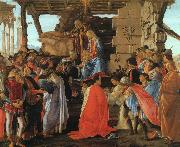

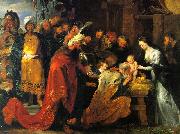
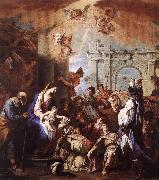

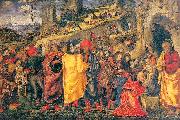
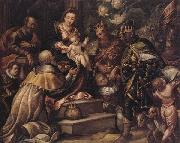

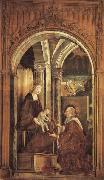
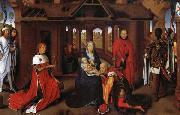
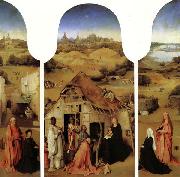
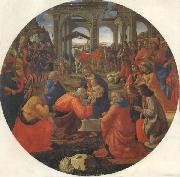
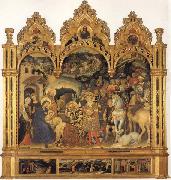
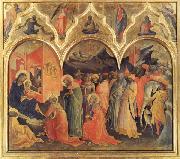
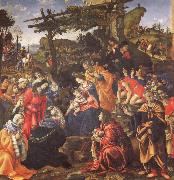
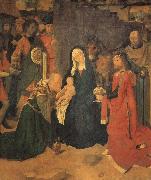

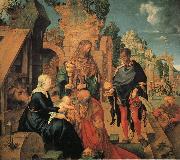

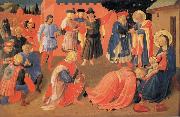
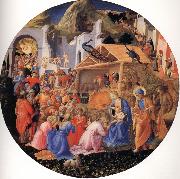
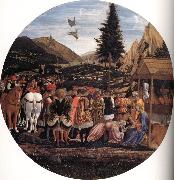
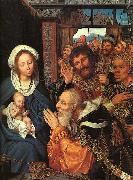
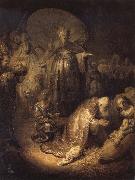
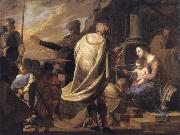
-494483.jpg)

